Uncut fan print (uchiwa-e), 295 x 230 mm, depicting kabuki actor Bandō Shūka I as Shirai Gonpachi (白井権八) reading a scroll by the light of a lantern. From the series A Parody of the Five Chivalrous Commoners; a Cup of Sake From Their Fans (Mitate gonin otoko, go-hiiki no omoizashi). According to Paul Griffith, the term omoizashi refers to the act of pouring a cup of sake for one's chosen partner, here giving an impression of intimacy and affection between famous actors and their patrons.
Actor: Bandō Shūka I [初代坂東しうか] (Japanese, 1813-1855); other names: Bandō Tamasaburō I, Bandō Mitsugorō V (posthumously). The print was probably published by some unknown Yama-Ta (Marks U421b). Double nanushi censor seals and date seal: Muramatsu and Fuku, Kaei 5, 2nd month (2/1852). As Kabuki Encyclopedia put it: "Gonpachi. A parasite. From the character named Shirai Gonpachi who lives at the home of Banzui Chōbei and sponges off him" (An English-Langauge Adaptation of Kabuki Jiten. Samuel L. Leiter. Greenwood Press, 1979, pp. 26, 98-9). There were many kabuki plays based on the story of the lovers Miura-ya Komurasaki and Shirai Gonpachi. (See: [LIB-2226.2019] Algernon Bertram Freeman-Mitford. Tales of Old Japan. — London: Macmillan and Co., 1883). Ref.: Art shop Ezoshi Ukiyoe new collection news, vol. 66, 2023.1 (Jan) # 31, p.8.-
 Utagawa Kunisada [歌川 国貞] a.k.a. Utagawa Toyokuni III [三代歌川豊国] (Japanese, 1786 – 1865).
Utagawa Kunisada [歌川 国貞] a.k.a. Utagawa Toyokuni III [三代歌川豊国] (Japanese, 1786 – 1865). -
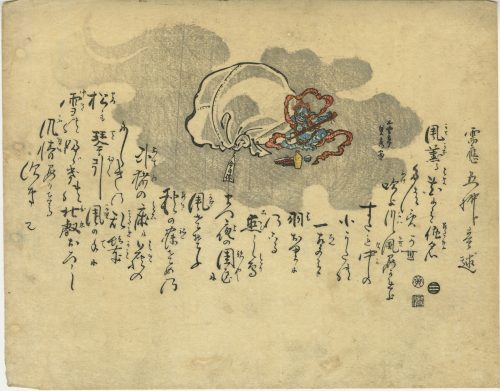 Artist: Utagawa Sadahide [歌川 貞秀], a.k.a. Gountei Sadahide [五雲亭 貞秀] (Japanese, 1807 – c. 1878-9). Publisher: Ibaya Senzaburō [伊場屋仙三郎] (Japanese, c. 1815 – 1869). Date-kiwame seal: 1831 (Tenpō 2). Size: Uchiwa-e, 298 x 232 mm. Pair of uncut fan prints (1) with the god of wind and (2) with the god of thunder meant to be pasted on two sides of a fan.
Artist: Utagawa Sadahide [歌川 貞秀], a.k.a. Gountei Sadahide [五雲亭 貞秀] (Japanese, 1807 – c. 1878-9). Publisher: Ibaya Senzaburō [伊場屋仙三郎] (Japanese, c. 1815 – 1869). Date-kiwame seal: 1831 (Tenpō 2). Size: Uchiwa-e, 298 x 232 mm. Pair of uncut fan prints (1) with the god of wind and (2) with the god of thunder meant to be pasted on two sides of a fan.

-
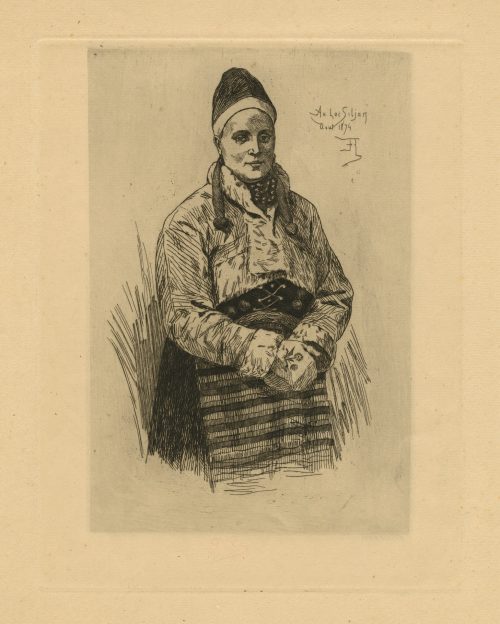
Etching on laid paper, monogrammed in the plate and inscribed "Au Lac Siljan, Août 1874". Owner's stamp LVM on verso.
Dimensions: Paper: 47 x 34 cm; Plate: 24 x 19 cm; Image: 21 x 14 cm.
Catalogue raisonné: Rouir 858:5; Arthur Hubschmid (1977): 320.
-
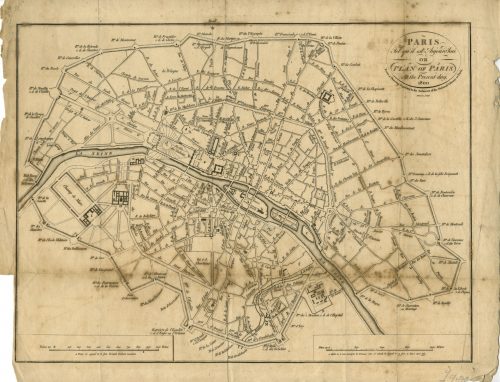 Title: PARIS | Tel qu'il est Aujourd'hui | OR | PLAN OF PARIS | At the Present day. 1800 | From a Drawing deposited in the Archieves of the National Library at Paris | Menzies sculpt. || Contributor: Menzies, John (British, fl. c. 1792 – 1851) – engraver. Ref: Gallica.
Title: PARIS | Tel qu'il est Aujourd'hui | OR | PLAN OF PARIS | At the Present day. 1800 | From a Drawing deposited in the Archieves of the National Library at Paris | Menzies sculpt. || Contributor: Menzies, John (British, fl. c. 1792 – 1851) – engraver. Ref: Gallica. -
 Poem by Ariwara no Narihira Ason: (Actor Ichikawa Danjûrô VIII as) Seigen, from the series Comparisons for Thirty-six Selected Poems (Mitate sanjûrokkasen no uchi)「見立三十六歌撰之内 有原業平朝臣 清玄」 八代目市川団十郎. Poem: Yo no naka ni/ taete sakura no/ nakariseba/ haru no kokoro wa/ nodokekaramashi. Kabuki actor: Ichikawa Danjūrō VIII [八代目 市川 團十郎] (Japanese, 1823 – 1854); other names: Ichikawa Ebizô VI, Ichikawa Shinnosuke II. Artist: Utagawa Kunisada [歌川 国貞] a.k.a. Utagawa Toyokuni III [三代歌川豊国] (Japanese, 1786 – 1865). Block cutter: Yokokawa Horitake [横川彫武] a.k.a. Yokokawa Takejiro [横川竹二郎] (Japanese, fl. 1860s). Publisher: Iseya Kanekichi [伊勢屋兼吉] (Japanese, fl. 1840s – c. 1875) Year: 1852 (Kaei 5), 10th month. Size: Vertical ōban; 36.5 × 25.4 cm. Signed: Toyokuni ga, in toshidama cartouche [豊国画(年玉枠] Censors' seals: Fuku, (Muramatsu), Rat 10. Ref: MFA Accession № 11.36779.43.
Poem by Ariwara no Narihira Ason: (Actor Ichikawa Danjûrô VIII as) Seigen, from the series Comparisons for Thirty-six Selected Poems (Mitate sanjûrokkasen no uchi)「見立三十六歌撰之内 有原業平朝臣 清玄」 八代目市川団十郎. Poem: Yo no naka ni/ taete sakura no/ nakariseba/ haru no kokoro wa/ nodokekaramashi. Kabuki actor: Ichikawa Danjūrō VIII [八代目 市川 團十郎] (Japanese, 1823 – 1854); other names: Ichikawa Ebizô VI, Ichikawa Shinnosuke II. Artist: Utagawa Kunisada [歌川 国貞] a.k.a. Utagawa Toyokuni III [三代歌川豊国] (Japanese, 1786 – 1865). Block cutter: Yokokawa Horitake [横川彫武] a.k.a. Yokokawa Takejiro [横川竹二郎] (Japanese, fl. 1860s). Publisher: Iseya Kanekichi [伊勢屋兼吉] (Japanese, fl. 1840s – c. 1875) Year: 1852 (Kaei 5), 10th month. Size: Vertical ōban; 36.5 × 25.4 cm. Signed: Toyokuni ga, in toshidama cartouche [豊国画(年玉枠] Censors' seals: Fuku, (Muramatsu), Rat 10. Ref: MFA Accession № 11.36779.43. -
 Artist: Tsukioka Tanka [旦霞] (Japanese, fl. c. 1830s – 1840s). Publisher: Enshūya Matabei [遠州屋又兵衛] (Japanese, fl. c. 1768 – 1881); seal: Enmata. Title: Picture of Fuji, Tsukuba and Sumida River [富士筑波隅田川の圖] (フジ ツクバ スミダガワ ノ ズ | Fuji Tsukuba Sumidagawa no zu). Date seal 巳 + kiwame: Tenpō 4 (1833). Media: Fan print (uchiwa-e, 団扇絵), 235 x 302 mm, aizuri-e. Only four prints are known from this artist, all fans: (1) National Diet Library 2542868:
Artist: Tsukioka Tanka [旦霞] (Japanese, fl. c. 1830s – 1840s). Publisher: Enshūya Matabei [遠州屋又兵衛] (Japanese, fl. c. 1768 – 1881); seal: Enmata. Title: Picture of Fuji, Tsukuba and Sumida River [富士筑波隅田川の圖] (フジ ツクバ スミダガワ ノ ズ | Fuji Tsukuba Sumidagawa no zu). Date seal 巳 + kiwame: Tenpō 4 (1833). Media: Fan print (uchiwa-e, 団扇絵), 235 x 302 mm, aizuri-e. Only four prints are known from this artist, all fans: (1) National Diet Library 2542868:
(2) Ritsumeikan University mai30_07:

 (3) RISD Museum 34.334:
(3) RISD Museum 34.334:

-
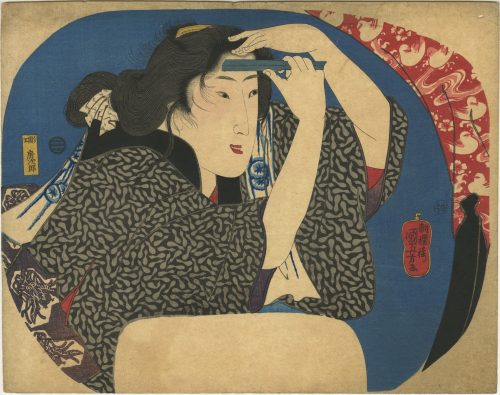 Artist: Utagawa Kuniyoshi [歌川 國芳] (Japanese, 1798 – 1861). Publisher: Ibaya Senzaburō [伊場屋仙三郎] (Japanese, fl. C. 1845 – 1847), seal: San [三] (Marks 11-001 | 127c). Carver: Matsushima Fusajirō [松嶋房次郎] (Japanese, fl. 1843 – 1850); seal [彫工房次郎] – Hori kō Fusajirō (Gordon Friese № 136) Signed: Chōōrō Kuniyoshi ga [朝櫻楼国芳画] in a red double gourd-shaped cartouche. Nanushi censor seal: Tanaka [田中]; V/1844 or II/1845. Media: Fan print (uchiwa-e, 団扇絵), 238 x 304 mm. Reference: Kuniyoshi Project. Series mentioned in Robert Schaap. Heroes and ghosts: Japanese prints by Kuniyoshi, 1797-1861.— Leiden: Hotei Publishing, 1998; p. 122 [LIB-1030.2016].
Artist: Utagawa Kuniyoshi [歌川 國芳] (Japanese, 1798 – 1861). Publisher: Ibaya Senzaburō [伊場屋仙三郎] (Japanese, fl. C. 1845 – 1847), seal: San [三] (Marks 11-001 | 127c). Carver: Matsushima Fusajirō [松嶋房次郎] (Japanese, fl. 1843 – 1850); seal [彫工房次郎] – Hori kō Fusajirō (Gordon Friese № 136) Signed: Chōōrō Kuniyoshi ga [朝櫻楼国芳画] in a red double gourd-shaped cartouche. Nanushi censor seal: Tanaka [田中]; V/1844 or II/1845. Media: Fan print (uchiwa-e, 団扇絵), 238 x 304 mm. Reference: Kuniyoshi Project. Series mentioned in Robert Schaap. Heroes and ghosts: Japanese prints by Kuniyoshi, 1797-1861.— Leiden: Hotei Publishing, 1998; p. 122 [LIB-1030.2016].
-
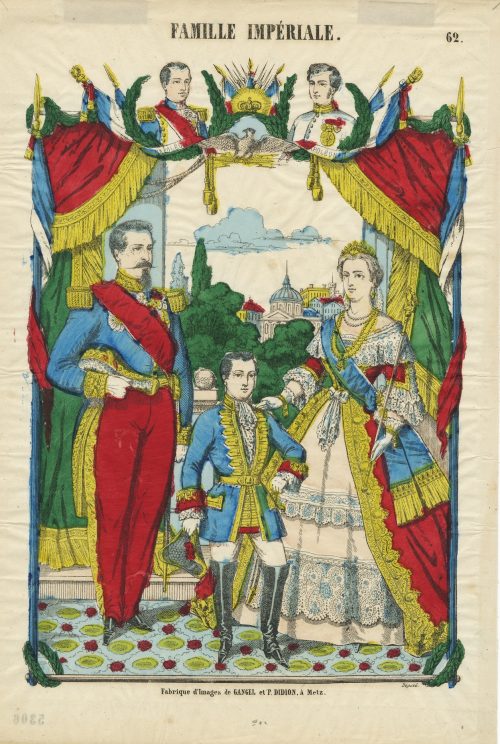 Hand-coloured woodcut on wove paper, 400 x 270 mm; black ink stamp “5306” to reverse. Top centre: "FAMILLE IMPÉRIALE", right: "62."; below centre: "Fabrique d'Images de GANGEL et P. DIDION, à Metz."; right: "Déposé." Publisher/printer: Gangel et P. Didion (Metz); Paulin Didion (French, 1831 – 1879). Characters: Napoleon III [Charles-Louis Napoléon Bonaparte] (French, 1808 – 1873) Eugénie de Montijo [L'impératrice Eugénie] (Spanish-French, 1826 – 1920) Napoléon, Prince Imperial (Napoléon Eugène Louis Jean Joseph Bonaparte] (French, 1856 – 1879) Napoléon II [Napoléon François Joseph Charles Bonaparte] (French, 1811 – 1832) Napoléon Ier [Napoléon Bonaparte] (French, 1769 – 1821)
Hand-coloured woodcut on wove paper, 400 x 270 mm; black ink stamp “5306” to reverse. Top centre: "FAMILLE IMPÉRIALE", right: "62."; below centre: "Fabrique d'Images de GANGEL et P. DIDION, à Metz."; right: "Déposé." Publisher/printer: Gangel et P. Didion (Metz); Paulin Didion (French, 1831 – 1879). Characters: Napoleon III [Charles-Louis Napoléon Bonaparte] (French, 1808 – 1873) Eugénie de Montijo [L'impératrice Eugénie] (Spanish-French, 1826 – 1920) Napoléon, Prince Imperial (Napoléon Eugène Louis Jean Joseph Bonaparte] (French, 1856 – 1879) Napoléon II [Napoléon François Joseph Charles Bonaparte] (French, 1811 – 1832) Napoléon Ier [Napoléon Bonaparte] (French, 1769 – 1821) -
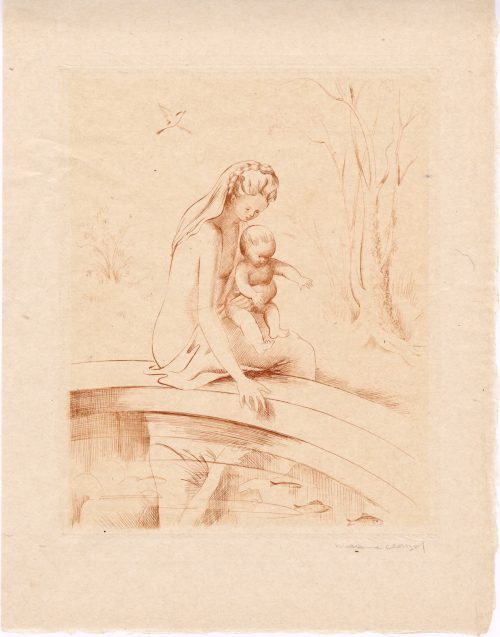 Set of 10 etchings (9 in passe-partout) printed in sanguine on the mother of pearl paper (japon nacre) from the album of 12 prints titled “Jeunesse”, presented by Gérard D'Houville (pen name of Marie de Régnier, née de Heredia) and published by La Tradition in 1945. It was a limited edition of 532 copies, some coloured on Arches paper and some as these set. Plates signed by the artist in pencil below the plate mark. The album cover is missing. Complete data for the album: JEUNESSE | 12 EAUX-FORTES ORIGINALES | DE | MARIANNE CLOUZOT | PRÉSENTÉES | PAR | GÉRARD D'HOUVILLE | {publisher’s device} | LA TRADITION | 1945 || Dimensions: mat 330 x 255 mm; window 225 x 180 mm; sheet 280 x 220 mm; plate 220 x 170 mm. Contributor: Martin van Maële [Martin, Maurice François Alfred] (French, 1863 – 1926)
Set of 10 etchings (9 in passe-partout) printed in sanguine on the mother of pearl paper (japon nacre) from the album of 12 prints titled “Jeunesse”, presented by Gérard D'Houville (pen name of Marie de Régnier, née de Heredia) and published by La Tradition in 1945. It was a limited edition of 532 copies, some coloured on Arches paper and some as these set. Plates signed by the artist in pencil below the plate mark. The album cover is missing. Complete data for the album: JEUNESSE | 12 EAUX-FORTES ORIGINALES | DE | MARIANNE CLOUZOT | PRÉSENTÉES | PAR | GÉRARD D'HOUVILLE | {publisher’s device} | LA TRADITION | 1945 || Dimensions: mat 330 x 255 mm; window 225 x 180 mm; sheet 280 x 220 mm; plate 220 x 170 mm. Contributor: Martin van Maële [Martin, Maurice François Alfred] (French, 1863 – 1926) -
 Artist: Utagawa Kunisada [歌川 国貞] a.k.a. Utagawa Toyokuni III [三代歌川豊国] (Japanese, 1786 – 1865). Publisher: Nishimuraya Yohachi [西村屋与八] (Japanese, fl. c. 1751 – 1860), seal name: Eijudō. Date: c. 1821–22 (Bunsei 4–5) Size: Ōban tate-e triptych, each sheet 36.8 x 26.4 cm. Signed: 五渡亭国貞画 – Gototei Kunisada ga (on center sheet). Censor’s seal: kiwame 改印: 極 A view of the dressing room of a Theater in Dōtonbori, Ōsaka (Ōsaka Dōtonbori shibai gakuya no zu): Right sheet: Actors Bandō Mitsuemon I, Asao Tamejūrō III, Ichikawa Danzō V, Nakamura Utaemon III, Bandō Mitsugorō III (in a costume of Matsuômaru), Kiriyama Monji III, Nakamura Utashichi II, Arashi Shôroku IV, Nakamura Matsue III, Matsumoto Kōshirō V, Ichikawa Komazō V. Centre sheet: Arashi Mitsugorō III, Mimasu Daigorō III, Nakayama Bunshichi III, Ichikawa Ichizō II, Bandō Minosuke II, Ichikawa Omezō I, Arashi Kitsusaburō I, Nakamura Utaroku I, Kataoka Nizaemon VII, Ōtani Tomoemon III, Asao Yūjirō I. Left sheet: Asao Kuzaemon I, Arashi Hidenosuke III, Sawamura Gennosuke II, Iwai Ōginosuke, Sawamura Kunitarō II, Iwai Matsunosuke I, Ichikawa Sōzaburō IV, Iwai Hanshirō V (in a costume of Sakuramaru), and Ichikawa Shinzō III (L). The actors are making up for a performance of the “Carriage-Stopping” scene from Sugawara Denju Tenarai Kagami (Sugawara Denju and the Secrets of Calligraphy). References: MFA Accession №: 11.43384a-c; Catalogue Raisonné: Izzard, Kunisada’s World (1993), #34; Hizô Ukiyo-e taikan/Ukiyo-e Masterpieces in European Collections 5, Victoria and Albert Museum II (1987), pl. 22; Keyes, PMA Osaka cat. (1973), #250 and pl. 15 (The theatrical world of Osaka prints, by Roger S. Keyes and Keiko Mizushima, Philadelphia Museum of Art, 1973), pp. 70-71); Izzard, Kunisada's world revisited, 2021; V&A Accession № E.5995-1886. Kabuki actors on this print: Arashi Hidenosuke III [嵐秀之助] (Japanese, fl. 1794 – 1837); other names: Arashi Koshichi IV, Arashi Hinasuke IV, Arashi Sanjūrō VI, Kanō Hidenosuke II, Kanō Umetarō, Arashi Iwajirō III. Arashi Kitsusaburō I [嵐橘三郎] (Japanese, 1769 – 1821); other names: Arashi Kichisaburō II, Arashi Rikan I. Arashi Mitsugorō III (Japanese, ? – ?) Arashi Shōroku IV [四代目嵐小六] (Japanese, 1783 – 1826) Asao Kuzaemon I [浅尾工左衛門] (Japanese, 1758 – 1824); other names: Asai Kuzaemon Nakayama Tashirō II Takeda Nisaburō. Asao Tamejūrō III [三代目淺尾爲十郎] (Japanese, 1780 – 1836); other names: Asao Okuyama III, Asao Okuyama III, Asao Tomozō I. Asao Yūjirō I [浅尾勇次郎] (Japanese, 1782 – 1835); other names: Jitsukawa Gakujūrō I, Asao Gakujūrō, Nakamura Yaozō, Asao Yaozō. Bandō Minosuke II [坂東蓑助] (Japanese, 1802 – 1863); other names: Morita Kan'ya XI, Bandô Mitsugorō IV. Bandō Mitsuemon I [坂東三津右衛門] (Japanese, 1788 – 1846); other names: Bandō Kumahei [坂東熊平]. Bandō Mitsugorō III [三代目 坂東 三津五郎] (Japanese, 1775 – 1831); other names: Bandō Minosuke I, Morita Kanjirô II, Bandō Mitahachi I, Bandō Minosuke I, Bandō Mitahachi I. Ichikawa Danzō V [市川団蔵] (Japanese, 1788 – 1845); other names: Ichikawa Shikō I, Ichikawa Danzaburō IV, Ichikawa Danjirō I, Ichikawa Morinosuke I. Ichikawa Ichizō II [市川市蔵] (Japanese, 1806 – 1829); other names Ichikawa Ebijūrō II, Ichikawa Sukezō I. Ichikawa Komazō V [市川高麗蔵] (Japanese, 1812 – 1849); other names: Matsumoto Kinshō I, Matsumoto Kōshirō VI, Matsumoto Kinshi. Ichikawa Omezō I [市川男女蔵] (Japanese, 1781 – 1833); other names: Ichikawa Benzō II, Ichikawa Bennosuke. Ichikawa Shinzō III [市川新蔵] (Japanese, 1793 – 1837); other names: Ichikawa Sumizō III, Nakayama Tomisaburô II, Nakayama Kinsha, Nakayama Tomisaburō II, Ichikawa Komazō IV, Ichikawa Santarō. Ichikawa Sōzaburō IV (Japanese, ? – ?) Iwai Hanshirō V [岩井半四郎] (Japanese, 1776 – 1847); other names: Iwai Tojaku, Iwai Kumesaburō I. Iwai Matsunosuke I [岩井松之助] (Japanese, 1804 – 1845); other names: Iwai Hanshirō VII, Iwai Shijaku I, Iwai Komurasaki I. Iwai Ōginosuke (Japanese, ? – ?) Kataoka Nizaemon VII [七代目片岡仁左衛門] (Japanese, 1755 – 1837); other names: Yamazawa Kunigorō, Asao Kunigorō II, Nakamura Matsusuke. Kiriyama Monji III [桐山紋治] (Japanese, fl. c. 1803 – 1830); other names: Ichikawa Takigorō. Matsumoto Kōshirō V [五代目松本幸四郎] (Japanese, 1764-1838); other names: Ichikawa Komazô III, Ichikawa Sumizô I. Mimasu Daigorō III [三枡大五郎] (Japanese, 1782 – 1824); other names: Mimasu Seibē, Yoshizawa Kamezō. Nakamura Matsue III [三代目中村松江] (Japanese, 1786-1855); other names: Nakamura Sankō I, Nakamura Tomijūrō II, Ichikawa Kumatarō. Nakamura Utaemon III [中村歌右衛門] (Japanese, 1778 – 1838); other names: Nakamura Tamasuke, Nakamura Baigyoku I, Nakamura Shikan I, Kagaya Fukunosuke I. Nakamura Utaroku I (Japanese, ? – ?) Nakamura Utashichi II (Japanese, ? – ?) Nakayama Bunshichi III [三代目目中山文七] (Japanese, 1764 – 1853); other names: Nakayama Hyakka, Nakayama Hyōtarō I, Nakayama Tokusaburō. Ōtani Tomoemon III [大谷友右衛門] (Japanese, 1793–1839); other names: Arashi Shagan IV, Arashi Sanpachi II, Nakayama Monzaburō. Sawamura Gennosuke II [沢村源之助](Japanese, 1802/7 – 1853); other names: Suketakaya Takasuke III, Sawamura Chōjūrō V, Sawamura Sōjūrō V, Sawamura Tosshō I, Sawamura Genpei I. Sawamura Kunitarō II [沢村国太郎](Japanese, 1798 – 1836); other names: Ogino Kinshi, Ogino Yaegiri III, Ogino Kamekichi, Izumikawa Kamekichi.
Artist: Utagawa Kunisada [歌川 国貞] a.k.a. Utagawa Toyokuni III [三代歌川豊国] (Japanese, 1786 – 1865). Publisher: Nishimuraya Yohachi [西村屋与八] (Japanese, fl. c. 1751 – 1860), seal name: Eijudō. Date: c. 1821–22 (Bunsei 4–5) Size: Ōban tate-e triptych, each sheet 36.8 x 26.4 cm. Signed: 五渡亭国貞画 – Gototei Kunisada ga (on center sheet). Censor’s seal: kiwame 改印: 極 A view of the dressing room of a Theater in Dōtonbori, Ōsaka (Ōsaka Dōtonbori shibai gakuya no zu): Right sheet: Actors Bandō Mitsuemon I, Asao Tamejūrō III, Ichikawa Danzō V, Nakamura Utaemon III, Bandō Mitsugorō III (in a costume of Matsuômaru), Kiriyama Monji III, Nakamura Utashichi II, Arashi Shôroku IV, Nakamura Matsue III, Matsumoto Kōshirō V, Ichikawa Komazō V. Centre sheet: Arashi Mitsugorō III, Mimasu Daigorō III, Nakayama Bunshichi III, Ichikawa Ichizō II, Bandō Minosuke II, Ichikawa Omezō I, Arashi Kitsusaburō I, Nakamura Utaroku I, Kataoka Nizaemon VII, Ōtani Tomoemon III, Asao Yūjirō I. Left sheet: Asao Kuzaemon I, Arashi Hidenosuke III, Sawamura Gennosuke II, Iwai Ōginosuke, Sawamura Kunitarō II, Iwai Matsunosuke I, Ichikawa Sōzaburō IV, Iwai Hanshirō V (in a costume of Sakuramaru), and Ichikawa Shinzō III (L). The actors are making up for a performance of the “Carriage-Stopping” scene from Sugawara Denju Tenarai Kagami (Sugawara Denju and the Secrets of Calligraphy). References: MFA Accession №: 11.43384a-c; Catalogue Raisonné: Izzard, Kunisada’s World (1993), #34; Hizô Ukiyo-e taikan/Ukiyo-e Masterpieces in European Collections 5, Victoria and Albert Museum II (1987), pl. 22; Keyes, PMA Osaka cat. (1973), #250 and pl. 15 (The theatrical world of Osaka prints, by Roger S. Keyes and Keiko Mizushima, Philadelphia Museum of Art, 1973), pp. 70-71); Izzard, Kunisada's world revisited, 2021; V&A Accession № E.5995-1886. Kabuki actors on this print: Arashi Hidenosuke III [嵐秀之助] (Japanese, fl. 1794 – 1837); other names: Arashi Koshichi IV, Arashi Hinasuke IV, Arashi Sanjūrō VI, Kanō Hidenosuke II, Kanō Umetarō, Arashi Iwajirō III. Arashi Kitsusaburō I [嵐橘三郎] (Japanese, 1769 – 1821); other names: Arashi Kichisaburō II, Arashi Rikan I. Arashi Mitsugorō III (Japanese, ? – ?) Arashi Shōroku IV [四代目嵐小六] (Japanese, 1783 – 1826) Asao Kuzaemon I [浅尾工左衛門] (Japanese, 1758 – 1824); other names: Asai Kuzaemon Nakayama Tashirō II Takeda Nisaburō. Asao Tamejūrō III [三代目淺尾爲十郎] (Japanese, 1780 – 1836); other names: Asao Okuyama III, Asao Okuyama III, Asao Tomozō I. Asao Yūjirō I [浅尾勇次郎] (Japanese, 1782 – 1835); other names: Jitsukawa Gakujūrō I, Asao Gakujūrō, Nakamura Yaozō, Asao Yaozō. Bandō Minosuke II [坂東蓑助] (Japanese, 1802 – 1863); other names: Morita Kan'ya XI, Bandô Mitsugorō IV. Bandō Mitsuemon I [坂東三津右衛門] (Japanese, 1788 – 1846); other names: Bandō Kumahei [坂東熊平]. Bandō Mitsugorō III [三代目 坂東 三津五郎] (Japanese, 1775 – 1831); other names: Bandō Minosuke I, Morita Kanjirô II, Bandō Mitahachi I, Bandō Minosuke I, Bandō Mitahachi I. Ichikawa Danzō V [市川団蔵] (Japanese, 1788 – 1845); other names: Ichikawa Shikō I, Ichikawa Danzaburō IV, Ichikawa Danjirō I, Ichikawa Morinosuke I. Ichikawa Ichizō II [市川市蔵] (Japanese, 1806 – 1829); other names Ichikawa Ebijūrō II, Ichikawa Sukezō I. Ichikawa Komazō V [市川高麗蔵] (Japanese, 1812 – 1849); other names: Matsumoto Kinshō I, Matsumoto Kōshirō VI, Matsumoto Kinshi. Ichikawa Omezō I [市川男女蔵] (Japanese, 1781 – 1833); other names: Ichikawa Benzō II, Ichikawa Bennosuke. Ichikawa Shinzō III [市川新蔵] (Japanese, 1793 – 1837); other names: Ichikawa Sumizō III, Nakayama Tomisaburô II, Nakayama Kinsha, Nakayama Tomisaburō II, Ichikawa Komazō IV, Ichikawa Santarō. Ichikawa Sōzaburō IV (Japanese, ? – ?) Iwai Hanshirō V [岩井半四郎] (Japanese, 1776 – 1847); other names: Iwai Tojaku, Iwai Kumesaburō I. Iwai Matsunosuke I [岩井松之助] (Japanese, 1804 – 1845); other names: Iwai Hanshirō VII, Iwai Shijaku I, Iwai Komurasaki I. Iwai Ōginosuke (Japanese, ? – ?) Kataoka Nizaemon VII [七代目片岡仁左衛門] (Japanese, 1755 – 1837); other names: Yamazawa Kunigorō, Asao Kunigorō II, Nakamura Matsusuke. Kiriyama Monji III [桐山紋治] (Japanese, fl. c. 1803 – 1830); other names: Ichikawa Takigorō. Matsumoto Kōshirō V [五代目松本幸四郎] (Japanese, 1764-1838); other names: Ichikawa Komazô III, Ichikawa Sumizô I. Mimasu Daigorō III [三枡大五郎] (Japanese, 1782 – 1824); other names: Mimasu Seibē, Yoshizawa Kamezō. Nakamura Matsue III [三代目中村松江] (Japanese, 1786-1855); other names: Nakamura Sankō I, Nakamura Tomijūrō II, Ichikawa Kumatarō. Nakamura Utaemon III [中村歌右衛門] (Japanese, 1778 – 1838); other names: Nakamura Tamasuke, Nakamura Baigyoku I, Nakamura Shikan I, Kagaya Fukunosuke I. Nakamura Utaroku I (Japanese, ? – ?) Nakamura Utashichi II (Japanese, ? – ?) Nakayama Bunshichi III [三代目目中山文七] (Japanese, 1764 – 1853); other names: Nakayama Hyakka, Nakayama Hyōtarō I, Nakayama Tokusaburō. Ōtani Tomoemon III [大谷友右衛門] (Japanese, 1793–1839); other names: Arashi Shagan IV, Arashi Sanpachi II, Nakayama Monzaburō. Sawamura Gennosuke II [沢村源之助](Japanese, 1802/7 – 1853); other names: Suketakaya Takasuke III, Sawamura Chōjūrō V, Sawamura Sōjūrō V, Sawamura Tosshō I, Sawamura Genpei I. Sawamura Kunitarō II [沢村国太郎](Japanese, 1798 – 1836); other names: Ogino Kinshi, Ogino Yaegiri III, Ogino Kamekichi, Izumikawa Kamekichi. -
 Isoda Koryūsai (礒田 湖龍斎, 1735–1790), flourished: 1769 to 1790. The print lacks signature (signature erased).
Isoda Koryūsai (礒田 湖龍斎, 1735–1790), flourished: 1769 to 1790. The print lacks signature (signature erased).Attributed definitely to Koryūsai: Jacob Pins, #491 [p.202] - Saigyo Hoshi admiring Mount Fuji. Signature erased but convincingly attributed to Koryusai. Tikotin Museum, Haifa. Catalogue raisonné: Allen Hockley: A3-J-5 (p. 261).
Saigyō Hōshi (西行 法師, 1118 – March 23, 1190) was a famous Japanese poet of the late Heian and early Kamakura period. -
 Ichikawa Ebizo V (1791 – 1859) a.k.a. Ichikawa Danjûrô VII was a great-great-great-son of Ichikawa Danjûrô I. He started his stage career in 1794, at the age of 4, playing in Shibaraku (the role he is depicted here). During his stage life, he played every role type. He was later banished from Edo for living too luxurious life for an actor. While in exile he flourished in Kioto and Osaka. Kichirei (Festive Annual Custom). Publisher: Takenouchi Magohachi (Hoeidô) Circa 1833. Description: 役者の舞台姿を描いた「舞台姿」シリーズと、日常図を描いた「千社詣」シリーズがあり、同じ役者が向かい合って対になる。(『五渡亭国貞』). Signed: Gototei Kunisada ga [五渡亭国貞画]. Censor's seal: kiwame 改印:極. Ref.: Shindo, Gototei Kunisada Yakusha-e no Sekai (1993), plate 88; Utagawa Kunisada, 150th Anniversary of His Death, Ota Memorial Museum, no. 169; MFA ACCESSION NUMBER 11.43128.
Ichikawa Ebizo V (1791 – 1859) a.k.a. Ichikawa Danjûrô VII was a great-great-great-son of Ichikawa Danjûrô I. He started his stage career in 1794, at the age of 4, playing in Shibaraku (the role he is depicted here). During his stage life, he played every role type. He was later banished from Edo for living too luxurious life for an actor. While in exile he flourished in Kioto and Osaka. Kichirei (Festive Annual Custom). Publisher: Takenouchi Magohachi (Hoeidô) Circa 1833. Description: 役者の舞台姿を描いた「舞台姿」シリーズと、日常図を描いた「千社詣」シリーズがあり、同じ役者が向かい合って対になる。(『五渡亭国貞』). Signed: Gototei Kunisada ga [五渡亭国貞画]. Censor's seal: kiwame 改印:極. Ref.: Shindo, Gototei Kunisada Yakusha-e no Sekai (1993), plate 88; Utagawa Kunisada, 150th Anniversary of His Death, Ota Memorial Museum, no. 169; MFA ACCESSION NUMBER 11.43128. -
 Artist: Utagawa Kunisada [歌川 国貞] a.k.a. Utagawa Toyokuni III [三代歌川豊国] (Japanese, 1786 – 1865). Signed: Toyokuni ga [豊国 画] in a red toshidama cartouche. Publisher: Ibaya Senzaburō [伊場屋仙三郎] (Japanese, c. 1815 – 1869). Double nanushi censor seals: Hama & Magome, Kaei 2-5 (1849 – 1852). An uncut fan print (uchiwa-e, 220 x 292 mm) depicts a beautiful woman sitting on a balcony overlooking a bay and reading a book. Above the book, there is an obi with a pattern of stripes or modified key fret motif, with lettering that reads: 菅原島 [Sugawara-jima] and 美立 [mitate]. The lettering and the blossoming plum branch next to the obi provide an allusion to Sugawara no Michizane [菅原 道真/菅原 道眞] (Japanese, 845 – 903) - a prominent scholar and poet of Heian period exiled from Kyoto to the island of Kyushu as a result of another courtier's slander. A legend says that his beloved plum tree was so fond of its master that it flew to Kyushu with Sugawara. The Davis Museum at Wellesley College describes the print as belonging to the series A Parody of Sugawara Stripe Patterns (Mitate Sugawara-jima). To make the fact of an allusion transparent, Kunisada had changed the usual way of writing "Sugawara stripes" from 菅原縞 to 菅原島 and "mitate" from 見立 to 美立. An unusual spelling was also used to provide additional information to the reader in other cultures. E.g. during the Prohibition Era, the West Coast United States speakeasy bars and bordellos misspelt the items on a menu ("scollops") or in a neon sign ("Martuni's") to tell: here we have more pleasures for you than you may have expected. After Tenpō reforms, the printing of bijin-ga (美人画, "picture of beautiful woman") images was restricted. Our print disguises a typical bijin-ga as an advertisement of an obi (帯, a kimono sash) fabric pattern. "The market of portraits was satisfied and the authorities fooled" [Rebecca Salter. Japanese popular prints. — Honolulu: University of Hawaii Press, 2006].
Artist: Utagawa Kunisada [歌川 国貞] a.k.a. Utagawa Toyokuni III [三代歌川豊国] (Japanese, 1786 – 1865). Signed: Toyokuni ga [豊国 画] in a red toshidama cartouche. Publisher: Ibaya Senzaburō [伊場屋仙三郎] (Japanese, c. 1815 – 1869). Double nanushi censor seals: Hama & Magome, Kaei 2-5 (1849 – 1852). An uncut fan print (uchiwa-e, 220 x 292 mm) depicts a beautiful woman sitting on a balcony overlooking a bay and reading a book. Above the book, there is an obi with a pattern of stripes or modified key fret motif, with lettering that reads: 菅原島 [Sugawara-jima] and 美立 [mitate]. The lettering and the blossoming plum branch next to the obi provide an allusion to Sugawara no Michizane [菅原 道真/菅原 道眞] (Japanese, 845 – 903) - a prominent scholar and poet of Heian period exiled from Kyoto to the island of Kyushu as a result of another courtier's slander. A legend says that his beloved plum tree was so fond of its master that it flew to Kyushu with Sugawara. The Davis Museum at Wellesley College describes the print as belonging to the series A Parody of Sugawara Stripe Patterns (Mitate Sugawara-jima). To make the fact of an allusion transparent, Kunisada had changed the usual way of writing "Sugawara stripes" from 菅原縞 to 菅原島 and "mitate" from 見立 to 美立. An unusual spelling was also used to provide additional information to the reader in other cultures. E.g. during the Prohibition Era, the West Coast United States speakeasy bars and bordellos misspelt the items on a menu ("scollops") or in a neon sign ("Martuni's") to tell: here we have more pleasures for you than you may have expected. After Tenpō reforms, the printing of bijin-ga (美人画, "picture of beautiful woman") images was restricted. Our print disguises a typical bijin-ga as an advertisement of an obi (帯, a kimono sash) fabric pattern. "The market of portraits was satisfied and the authorities fooled" [Rebecca Salter. Japanese popular prints. — Honolulu: University of Hawaii Press, 2006]. -
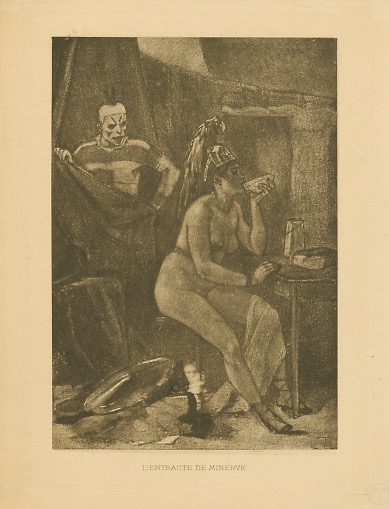
Photogravure after a pastel drawing by F. Rops. Monogrammed in the plate 'FR'. Owner's stamp 'LvM' on verso.
Dimensions: Paper: 26 x 20 cm; Plate: 25 x 18 cm; Image: 21 x 14.5 cm.
Catalogue raisonné: Arthur Hubschmid (1977): 543; Graphics irreverent and erotic (1968): 156.
-
 London: Published under the superintendence of the Society for the Diffusion of Useful Knowledge; Charles Knight & Co., no. 22 Ludgate Street. Dimensions: Sheet: 34 x 41.8 cm: Image: 28.7 x 38.3 cm. J. & C. Walker, Society for the Diffusion of Useful Knowledge Charles Knight & Co.; Charles Knight (British, 1791 – 1873) – publisher. J & C Walker (British firm, fl. 1820 – 1895) Walker, John (British, 1787 – 1873) Walker, Alexander (British, 1797? – 1870) Walker, Charles (British, 1799? – 1872) Society for the Diffusion of Useful Knowledge (SDUK) (British firm, 1826 – 1846)
London: Published under the superintendence of the Society for the Diffusion of Useful Knowledge; Charles Knight & Co., no. 22 Ludgate Street. Dimensions: Sheet: 34 x 41.8 cm: Image: 28.7 x 38.3 cm. J. & C. Walker, Society for the Diffusion of Useful Knowledge Charles Knight & Co.; Charles Knight (British, 1791 – 1873) – publisher. J & C Walker (British firm, fl. 1820 – 1895) Walker, John (British, 1787 – 1873) Walker, Alexander (British, 1797? – 1870) Walker, Charles (British, 1799? – 1872) Society for the Diffusion of Useful Knowledge (SDUK) (British firm, 1826 – 1846) -
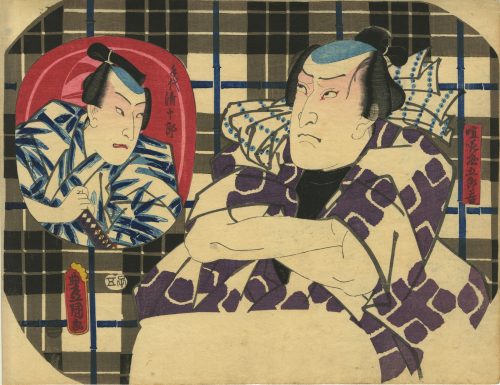 Artist: Utagawa Kunisada [歌川 国貞] a.k.a. Utagawa Toyokuni III [三代歌川豊国] (Japanese, 1786 – 1865). Publisher: Ibaya Senzaburō [伊場屋仙三郎] (Japanese, fl. C. 1845 – 1847). Date seal: [子五] Kaei 5, 5th month (5/1852). Signed: Toyokuni ga [豊国 画] in a red toshidama cartouche. Title: Actor Bandō Takesaburō I as clerk Seijūrō [手代清十郎] (left) and Actor Ichikawa Kodanji IV as Kenkaya Gorōkichi [喧嘩屋五郎吉] (right) in the play Musume ōgi tsui no tatehiki [娘扇一対侠贔屓 (むすめおうぎついのたてひき)] performed at the Nakamura theatre [中村座], in Edo (Tokyo). The playbill for this performance can be found at MFA (Boston) # 11.28042, 11.28285, 11.28286:
Artist: Utagawa Kunisada [歌川 国貞] a.k.a. Utagawa Toyokuni III [三代歌川豊国] (Japanese, 1786 – 1865). Publisher: Ibaya Senzaburō [伊場屋仙三郎] (Japanese, fl. C. 1845 – 1847). Date seal: [子五] Kaei 5, 5th month (5/1852). Signed: Toyokuni ga [豊国 画] in a red toshidama cartouche. Title: Actor Bandō Takesaburō I as clerk Seijūrō [手代清十郎] (left) and Actor Ichikawa Kodanji IV as Kenkaya Gorōkichi [喧嘩屋五郎吉] (right) in the play Musume ōgi tsui no tatehiki [娘扇一対侠贔屓 (むすめおうぎついのたてひき)] performed at the Nakamura theatre [中村座], in Edo (Tokyo). The playbill for this performance can be found at MFA (Boston) # 11.28042, 11.28285, 11.28286: Actors:
Bandō Takesaburō I (初代坂東竹三郎) (Japanese, 1832 – 1877); other names: Shinshi, Shinsui V, Bandō Hikosaburō V [五代目坂東彦三郎], Bandō Tsurunosuke I.
Ichikawa Kodanji IV [市川小團次] (Japanese, 1812 – 1866); other names: Ichikawa Yonejūrō I, Ichikawa Yonezō III, Ichikawa Eizō.
Actors:
Bandō Takesaburō I (初代坂東竹三郎) (Japanese, 1832 – 1877); other names: Shinshi, Shinsui V, Bandō Hikosaburō V [五代目坂東彦三郎], Bandō Tsurunosuke I.
Ichikawa Kodanji IV [市川小團次] (Japanese, 1812 – 1866); other names: Ichikawa Yonejūrō I, Ichikawa Yonezō III, Ichikawa Eizō.
Similar images were then used for the series Seven flourishing plants on lanterns for summer evenings [涼調珍盛の七草] (Suzumi chōchin sakari no nanakusa) published by Ibaya Senzaburō in 1852 (Kaei 5), 6th month.

Bandō Takesaburō I (carved by Yokokawa Takejirō): https://collections.mfa.org/objects/219360

Actor Ichikawa Kodanji IV (carved by Nakamura Tōkichi): https://collections.mfa.org/objects/477146.
-
 Artist: Utagawa Kunisada [歌川 国貞] a.k.a. Utagawa Toyokuni III [三代歌川豊国] (Japanese, 1786 – 1865). No publisher seal, no date or censor seal; probably a private printing. Signed: Kunisada ga [国貞画] in a red double gourd cartouche. Media: Untrimmed fan print (uchiwa-e), 231 x 294 mm, with the use of mica and black lacquer.
Artist: Utagawa Kunisada [歌川 国貞] a.k.a. Utagawa Toyokuni III [三代歌川豊国] (Japanese, 1786 – 1865). No publisher seal, no date or censor seal; probably a private printing. Signed: Kunisada ga [国貞画] in a red double gourd cartouche. Media: Untrimmed fan print (uchiwa-e), 231 x 294 mm, with the use of mica and black lacquer. -
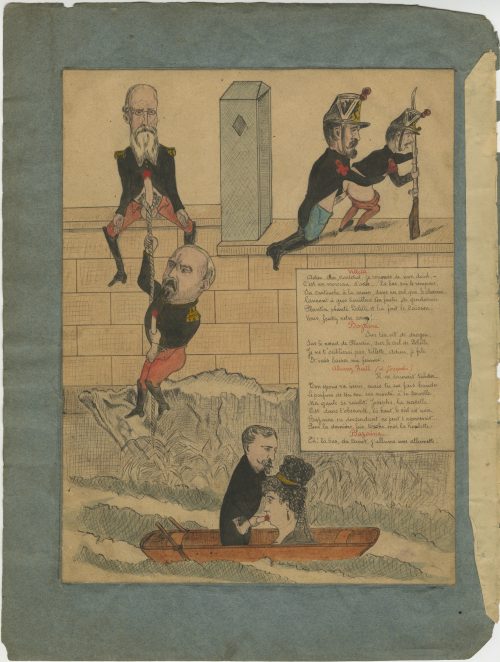 A series of seven political caricatures with indecent content, ink and pigment on paper, bound in a grey-blue folder. Each drawing is pasted to a grey-blue sheet of paper 32 x 24 cm. PLATES: 1) Villette; Bazaine; Alvarez Rull: 250 x 192 mm
A series of seven political caricatures with indecent content, ink and pigment on paper, bound in a grey-blue folder. Each drawing is pasted to a grey-blue sheet of paper 32 x 24 cm. PLATES: 1) Villette; Bazaine; Alvarez Rull: 250 x 192 mm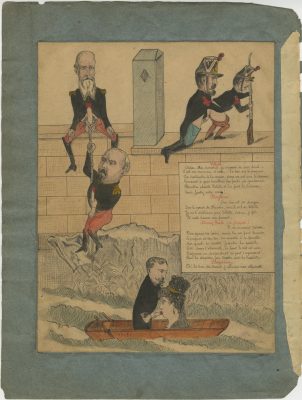
Villette Adieu, cher maréchal, je réponds de mon dard C’est un morceau d’acier… Là bas, sur le rempart, Sa cartouche à la main, dans un cul qui le charme, Lançant à gros bouillons son foutre de gendarme Plantin plante Delille et lui font le Caisson. Bazaine Sur ton vit de dragon Sur le nœud de Plantin, sur le cul de Delille, Je ne t’oublierai pas, Villette, adieu, je file Et je vais baiser ma femme. Alvarez Rull (à Josépha) Il ne saurait tarder, Ton epoux va venir, mais tu me fais bander, Le parfum de ton con me monte à la cervelle, Ma gaule se raidit . Josépha, la nacelle Est dans l’ obscurité, là haut, le ciel est noir, Bazaine en descendant ne peut t’ apercevoir … Pour la dernière fois, torche moi la houlette. Bazaine Eh ! là bas, du canot, j’allume une allumette!
Villette Farewell, dear Marshal, I vouch for my dick. It’s like a steel rod … Over there, on the ramparts, Plantin, his dick in hand, pounds Delisle’s beckoning ass And fills it with his bubbling gendarme’s cum. Bazaine For your dragoon’s dick, For Plantin's prick, for Delisle's ass, I won't forget you, Villette, goodbye, I'm leaving And I'm going to fuck my wife. Alvarez Rull (to Josépha) Hurry up, Your husband is coming, but I got a hard on you, The scent of your cunt penetrates my brain, My rod stiffened. Josépha, the gondola Is in the dark, the sky is black, Bazaine coming down and cannot see you... Give me one last blowjob.Bazaine Hey! Over there, from the canoe, I light a match!
French marshal Achille Bazaine capitulated to Bismarck during the Franco-Prussian war on 27 October 1870. In 1873, he was tried for treason and received a death sentence, later commuted to 20 years' imprisonment. Bazaine was incarcerated in the Fort Royal on Île Sainte-Marguerite, from which he escaped on August 9–10, 1874, with the help of Colonel Villette [Willette], his wife Josefa [Pepita Peña], and her nephew Alvarez Rull. They sailed to Genoa in Italy and from there to London. Plantin and Delisle were prison guards. The story was described in detail during the Trial of Col. Villette and his Accomplices in 1874 and published later in Robert Christophe. La Vie tragique du maréchal Bazaine. — Paris: Vautrain Jacques, 1947.
2) Impératrice Eugénie: 218 x 165 mm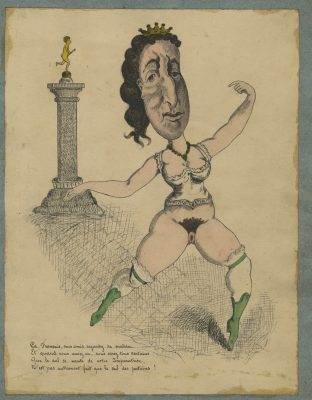
Ça, Français, mes amis, regardez sa matrice, Et quand vous aurez vu, vous serez tous certains Que le cul si vanté de votre Impératrice, N’est pas autrement fait que le cul des putains!
That, French, my friends, look at her cunt, And when you have seen, you will all be certain That the so acclaimed ass of your Empress, Is no different than the ass of whores! 3) Napoléon III: 215 x 168 mm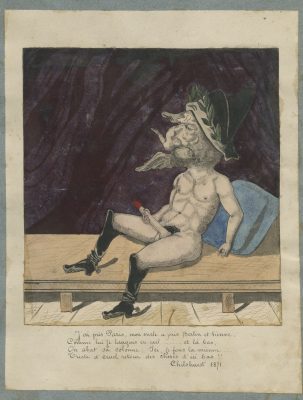
J’ai pris Paris, mon oncle a pris Berlin et Vienne. Comme lui je languis en exil …… et là bas, On abat sa colonne; Ici, je fous la mienne…. Triste et cruel retour des choses d’ici bas!! Chilshurst 1871. [i.e. Chislehurst]
I took Paris, my uncle took Berlin and Vienna. Like him, I, too, languish in exile. His column there was demolished; I’m jerking mine off here…. Cruel and sorrowful deeds!! 4) La confession: 216 x 168 mm (Georges Darboy?)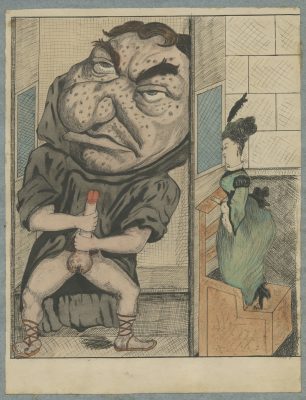 5) Napoléon III et Thérèsa (chanteuse Désirée Emma Valladon): 216 x 176 mm
5) Napoléon III et Thérèsa (chanteuse Désirée Emma Valladon): 216 x 176 mm
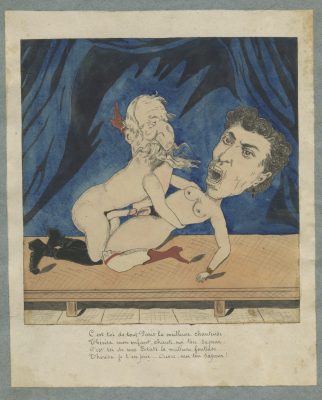
C’est toi de tout Paris la meilleure chanteuse, Thérèsa mon enfant, chante-moi ton sapeur. C’est toi de mes Etats la meilleure fonteuse.. Thérèsa je t’en prie … Ouvre-moi ton sapeur!
You, the best singer in all of Paris, Teresa, my child, sing for me where to insert. You are the best padding in my entire country… Teresa, please... Open your slit for me! 6) Thiers: 219 x 168 mm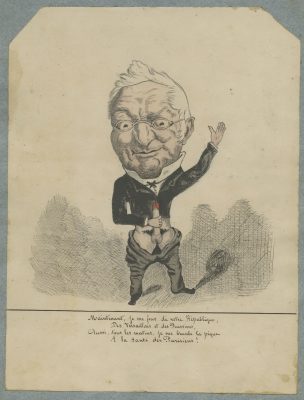
Maintenant, je me fous de votre République, Des Versaillais et des Prussiens, Aussi, tous les matins, je me branle la pique A la santé des Parisiens!
Yes, I don’t care about your Republic now, About Versailles and the Prussians, And every morning I jerk off For the health of Parisians! 7) Émile Ollivier/Rochefort/Jules Favre/Gambetta : 212 x 168 mm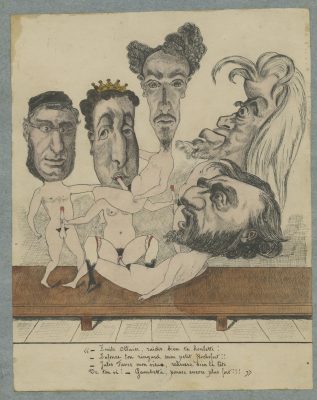
« — Emile Ollivier, raidis bien la houlette! — Enfonce ton ringard mon petit Rochefort!! — Jules Favre mon vieux, redresse bien la tête De ton vi! — Gambetta, pousse encore plus fort!!! »
Emile Ollivier, tighten your dick! - Stick in your poker, my little Rochefort!! - Jules Favre, old man, straighten your dickhead Damn it! – Gambetta, push even harder!!!Characters: Bazaine, François Achille (French, 1811 – 1888) Darboy, Georges (French, 1813 – 1871) Favre, Jules (French, 1809 – 1880) Gambetta, Léon (French, 1838 – 1882) Montijo, Eugénie de (Spanish-French, 1826 – 1920) Napoleon III [Bonaparte, Charles-Louis Napoléon] (French, 1808 – 1873) Ollivier, Émile (French, 1825 – 1913) Peña Azcárate, Josefa [Peña, Pepita] (Mexican-French, 1847 – 1900); Alvarez Rull – nephew of Josefa Peña Azcárate. Rochefort, Henri (French, 1831 – 1913) Thérésa [Valladon, Désirée Emma] (French, 1836 – 1913) Thiers, Adolphe (French, 1797 – 1877)
-
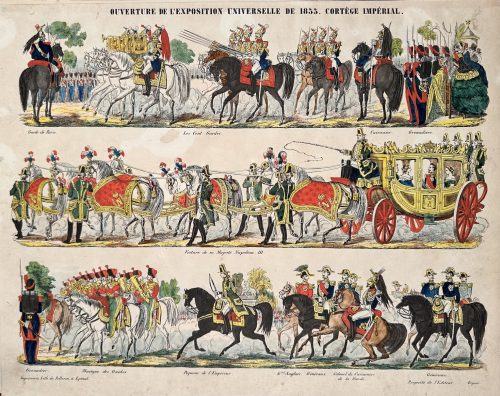 Hand-coloured woodcut on wove paper, 366 x 460 mm; black ink stamp “5057” to reverse. Caption cartoon in 2 tiers. Top: OUVERTURE DE 'EXPOSITION UNIVERSELLE DE 1855. CORTÈGE IMPÉRIAL. Captions top to bottom: Garde de Paris. — Les Cent Gardes. — Cuirassier. — Grenadiers. Middle: Voiture de sa Majesté Napoléon III. | Bottom: Grenadier. — Musique des Guides. — Piqueur de l’Empereur. — Gral Anglais — Généraux — Colonel de Cuirassiers | de la Garde — Généraux. Below left: Imprimerie Lith. de Pellerin, à Épinal; right: Propriété de l’Éditeur. Déposé. Jean Charles Pellerin (French, 1756 – 1836) – printer/publisher.
Hand-coloured woodcut on wove paper, 366 x 460 mm; black ink stamp “5057” to reverse. Caption cartoon in 2 tiers. Top: OUVERTURE DE 'EXPOSITION UNIVERSELLE DE 1855. CORTÈGE IMPÉRIAL. Captions top to bottom: Garde de Paris. — Les Cent Gardes. — Cuirassier. — Grenadiers. Middle: Voiture de sa Majesté Napoléon III. | Bottom: Grenadier. — Musique des Guides. — Piqueur de l’Empereur. — Gral Anglais — Généraux — Colonel de Cuirassiers | de la Garde — Généraux. Below left: Imprimerie Lith. de Pellerin, à Épinal; right: Propriété de l’Éditeur. Déposé. Jean Charles Pellerin (French, 1756 – 1836) – printer/publisher. -
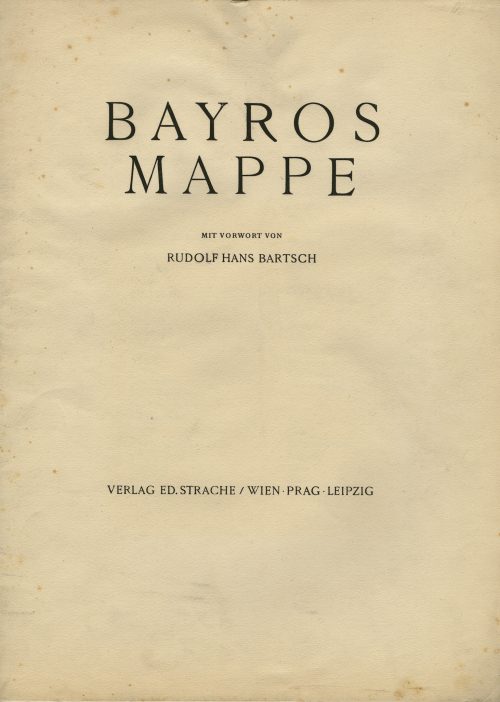 An album 45 of 50 prints, 31 photogravures and 14 in raster chromotype after drawings and paintings by Franz von Bayros; most with tissue guards, some in passepartout; colour prints mounted on the same paper that is used for photogravures. Title-page: BAYROS | MAPPE | MIT VORWORT VON | RUDOLF HANS BARTSCH | VERLAG ED. STRACHE / WIEN • PRAG • LEIPZIG || Limited edition of 500 copies. This is copy № 286. Lacking 5 prints: (1) Abschied vom Paradies, (2) Weihnacht, and (3) Harmonie from Symphonie von der Gūte, die Schönheit ist; (4) Divina commedia from Florentiner Phantasien; and (5) Mozart from Varia. Contributors: Franz von Bayros (Austrian, 1866 – 1924) Rudolf Hans Bartsch (Austrian, 1873 – 1952)
An album 45 of 50 prints, 31 photogravures and 14 in raster chromotype after drawings and paintings by Franz von Bayros; most with tissue guards, some in passepartout; colour prints mounted on the same paper that is used for photogravures. Title-page: BAYROS | MAPPE | MIT VORWORT VON | RUDOLF HANS BARTSCH | VERLAG ED. STRACHE / WIEN • PRAG • LEIPZIG || Limited edition of 500 copies. This is copy № 286. Lacking 5 prints: (1) Abschied vom Paradies, (2) Weihnacht, and (3) Harmonie from Symphonie von der Gūte, die Schönheit ist; (4) Divina commedia from Florentiner Phantasien; and (5) Mozart from Varia. Contributors: Franz von Bayros (Austrian, 1866 – 1924) Rudolf Hans Bartsch (Austrian, 1873 – 1952) -
 Artist: Utagawa Kunisada [歌川 国貞] a.k.a. Utagawa Toyokuni III [三代歌川豊国] (Japanese, 1786 – 1865). Signed: Ōju Toyokuni ga [応需豊国画], in a toshidama cartouche. Double nanushi censor seals: Mera & Murata (1846-50). Publisher: Kojimaya Jūbei [小嶋屋重兵衛] (Japanese, fl. c. 1797 – 1869). A beautiful woman, possibly a kabuki actor Iwai Hanshirō VIII [岩井半四郎] (Iwai Shijaku II, Iwai Kumesaburō III [岩井粂三郎], Iwai Hisajirō II, Japanese, 1829 – 1882), tuning the samisen on a veranda under the shining stars. The complete set of series Moon, Sun, Stars [月日星] (tsuki-hi-hoshi/boshi), three sources of light (sankō) [三光]:
Artist: Utagawa Kunisada [歌川 国貞] a.k.a. Utagawa Toyokuni III [三代歌川豊国] (Japanese, 1786 – 1865). Signed: Ōju Toyokuni ga [応需豊国画], in a toshidama cartouche. Double nanushi censor seals: Mera & Murata (1846-50). Publisher: Kojimaya Jūbei [小嶋屋重兵衛] (Japanese, fl. c. 1797 – 1869). A beautiful woman, possibly a kabuki actor Iwai Hanshirō VIII [岩井半四郎] (Iwai Shijaku II, Iwai Kumesaburō III [岩井粂三郎], Iwai Hisajirō II, Japanese, 1829 – 1882), tuning the samisen on a veranda under the shining stars. The complete set of series Moon, Sun, Stars [月日星] (tsuki-hi-hoshi/boshi), three sources of light (sankō) [三光]: -
 Kitagawa Utamaro. According to Chris Uhlenberg this is an illustration from the book Ehon koi no Onamaki, 3 vols, published in Kansei 11 (1799). Illustrated in b/w in: Hayashi Yoshikazu: Kitagawa Utamaro, in the series: Edo makura-e shi shusei, published in 1990, reissued 1994. Size: Chuban (25.5 x 18.5 cm), two book pages glued together.
Kitagawa Utamaro. According to Chris Uhlenberg this is an illustration from the book Ehon koi no Onamaki, 3 vols, published in Kansei 11 (1799). Illustrated in b/w in: Hayashi Yoshikazu: Kitagawa Utamaro, in the series: Edo makura-e shi shusei, published in 1990, reissued 1994. Size: Chuban (25.5 x 18.5 cm), two book pages glued together. -
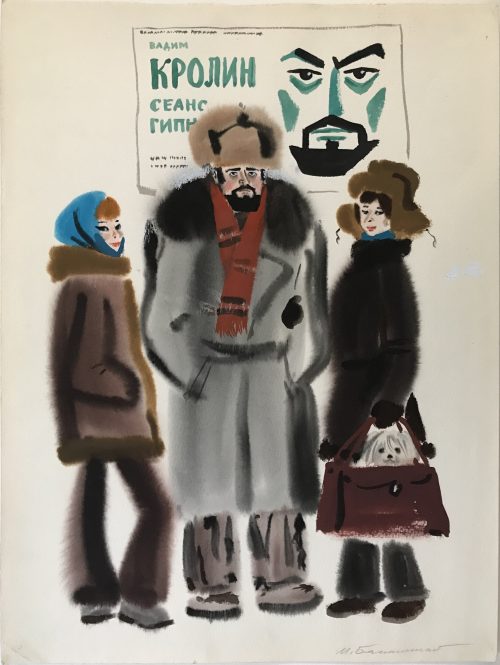 Mikhail Belomlinsky. Born 1934, Russia. Vadim Krolin, hypnosis session. Watercolor painting on paper from Chukotka expedition, ca. 1970s. Size: 36 x 48 cm.
Mikhail Belomlinsky. Born 1934, Russia. Vadim Krolin, hypnosis session. Watercolor painting on paper from Chukotka expedition, ca. 1970s. Size: 36 x 48 cm. -
 Title: Lyon Collection: Genji, Chapter 21, the maiden (otome - 乙女): the nine-tailed fox woman (kayō-fujin [花陽夫人]) terrorizing Prince Hanzoku (足王) and his servant from the series Japanese and Chinese parallels to Genji (wakan nazorae genji - 和漢准源氏). British Museum: Otome 乙女 (Maiden) / Waken nazorae Genji 和漢准源氏 (Japanese and Chinese Comparisons for the Chapters of the Genji). Schaap: Prince Hanzoku terrorized by a nine-tailed fox; Series: Wakan nazorae Genji (Japanese and Chinese parallels to Genji) Artist: Utagawa Kuniyoshi [歌川 國芳] (1798 – 1861). Publisher: Iseyoshi [伊勢芳] (Marks 25-013 | U095); seal [イせ芳]. Block carver: Hori Shōji [彫庄治] (Lyon Collection; BM); Hori Takichi [彫多吉] (Schaap). Date-aratame seal: Ansei 2, 7th month (1855). Ref: Jack Hillier. Japanese prints and drawings from the Vever Collection (3 volumes). — New York: Sotheby Parke Bernet & Rizzoli International, 1976; vol.3, p. 868, pl. 847. Robinson (1982): p. 161, S88, № 21. Schaap (1998): p. 115, № 107. SOLD
Title: Lyon Collection: Genji, Chapter 21, the maiden (otome - 乙女): the nine-tailed fox woman (kayō-fujin [花陽夫人]) terrorizing Prince Hanzoku (足王) and his servant from the series Japanese and Chinese parallels to Genji (wakan nazorae genji - 和漢准源氏). British Museum: Otome 乙女 (Maiden) / Waken nazorae Genji 和漢准源氏 (Japanese and Chinese Comparisons for the Chapters of the Genji). Schaap: Prince Hanzoku terrorized by a nine-tailed fox; Series: Wakan nazorae Genji (Japanese and Chinese parallels to Genji) Artist: Utagawa Kuniyoshi [歌川 國芳] (1798 – 1861). Publisher: Iseyoshi [伊勢芳] (Marks 25-013 | U095); seal [イせ芳]. Block carver: Hori Shōji [彫庄治] (Lyon Collection; BM); Hori Takichi [彫多吉] (Schaap). Date-aratame seal: Ansei 2, 7th month (1855). Ref: Jack Hillier. Japanese prints and drawings from the Vever Collection (3 volumes). — New York: Sotheby Parke Bernet & Rizzoli International, 1976; vol.3, p. 868, pl. 847. Robinson (1982): p. 161, S88, № 21. Schaap (1998): p. 115, № 107. SOLD -
 Artist: Utagawa Kunisada [歌川 国貞], a.k.a. Utagawa Toyokuni III [三代 歌川 豊国] (Japanese, 1786 – 1865). Signed: Toyokuni ga [豊国 画] in a red toshidama cartouche Block carver: Yokokawa Takejirō [横川竹二郎] (Japanese, fl. 1845 – 1863); seal: Hori Take [彫竹]. Publisher: Iseya Magobei [伊勢屋孫兵衛] (Japanese, fl. c. 1794 – 1868); seal: Hanmoto, Masu [板元, 益] (Marks 19-039 | 150d). Date-aratame seal: Ansei 2 (1855). Title: Time in Fukagawa, Iyo Province (Fukagawa Iyo setsu). Ref.: [LIB-3008.2022] Andreas Marks. Japanese woodblock prints: Artists, publishers and masterworks, 1680 – 1900. — Tuttle Publishing, 2010; p. 221. –> 1855 Kunisada. "Iyo Province-time at Fukagawa" (Fukagawa Iyo setsu). Fan print. Japan Ukiyo-e Museum, Matsumoto.
Artist: Utagawa Kunisada [歌川 国貞], a.k.a. Utagawa Toyokuni III [三代 歌川 豊国] (Japanese, 1786 – 1865). Signed: Toyokuni ga [豊国 画] in a red toshidama cartouche Block carver: Yokokawa Takejirō [横川竹二郎] (Japanese, fl. 1845 – 1863); seal: Hori Take [彫竹]. Publisher: Iseya Magobei [伊勢屋孫兵衛] (Japanese, fl. c. 1794 – 1868); seal: Hanmoto, Masu [板元, 益] (Marks 19-039 | 150d). Date-aratame seal: Ansei 2 (1855). Title: Time in Fukagawa, Iyo Province (Fukagawa Iyo setsu). Ref.: [LIB-3008.2022] Andreas Marks. Japanese woodblock prints: Artists, publishers and masterworks, 1680 – 1900. — Tuttle Publishing, 2010; p. 221. –> 1855 Kunisada. "Iyo Province-time at Fukagawa" (Fukagawa Iyo setsu). Fan print. Japan Ukiyo-e Museum, Matsumoto. -
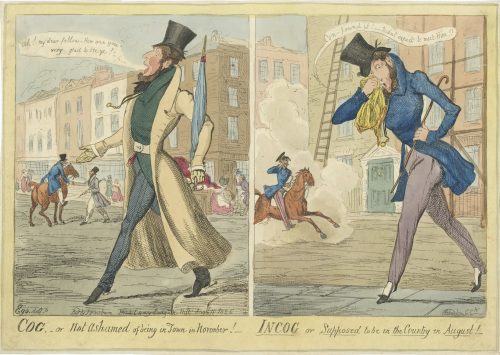 Description by British Museum (1865,1111.2128): "Two designs, side by side. [1] A dandy (probably a portrait), florid, whiskered, and bearded, steps jauntily from the pavement, hand extended, saying: Ah! my dear fellow — How are you? Devilish glad to see ye!— He holds a closed umbrella, ferrule erect, and wears a long tight-waisted coat to the heels, unbuttoned, tight pantaloons and spurred boots. In the middle distance, another dandy grasps the hand of a friend on horseback. Behind are houses with shop-fronts. A man raises his hat to a lady who curtseys. [2] The same dandy steps from the roadway onto the pavement, his handkerchief to his nose; he stoops, trying to conceal himself from a dandy cantering past in a cloud of dust, his eye-glass to his eye. He is without gloves, extraordinary for a dandy, and his trousers are strapped over pumps; he says: Con-found it! — Didn't expect to meet Him!! The street is otherwise empty; against the (large) houses are scaffolding and a tall ladder." Lettered with title, text within image including production details: 'Ego. delt / Etched by G. Ck / Pubd by J Fairburn Broadway Ludgate Hill August 18 1826'. Dimensions: Sheet: 25.5 x 36 cm, Image: 21.7 x 33.8 cm. Catalogue raisonné: A. M. Cohn (1924): № 1001, p. 262.: "A wretched plate. Difficult to believe G. C. had anything to do with it." — Bruton. Value.— £1.
Description by British Museum (1865,1111.2128): "Two designs, side by side. [1] A dandy (probably a portrait), florid, whiskered, and bearded, steps jauntily from the pavement, hand extended, saying: Ah! my dear fellow — How are you? Devilish glad to see ye!— He holds a closed umbrella, ferrule erect, and wears a long tight-waisted coat to the heels, unbuttoned, tight pantaloons and spurred boots. In the middle distance, another dandy grasps the hand of a friend on horseback. Behind are houses with shop-fronts. A man raises his hat to a lady who curtseys. [2] The same dandy steps from the roadway onto the pavement, his handkerchief to his nose; he stoops, trying to conceal himself from a dandy cantering past in a cloud of dust, his eye-glass to his eye. He is without gloves, extraordinary for a dandy, and his trousers are strapped over pumps; he says: Con-found it! — Didn't expect to meet Him!! The street is otherwise empty; against the (large) houses are scaffolding and a tall ladder." Lettered with title, text within image including production details: 'Ego. delt / Etched by G. Ck / Pubd by J Fairburn Broadway Ludgate Hill August 18 1826'. Dimensions: Sheet: 25.5 x 36 cm, Image: 21.7 x 33.8 cm. Catalogue raisonné: A. M. Cohn (1924): № 1001, p. 262.: "A wretched plate. Difficult to believe G. C. had anything to do with it." — Bruton. Value.— £1. -
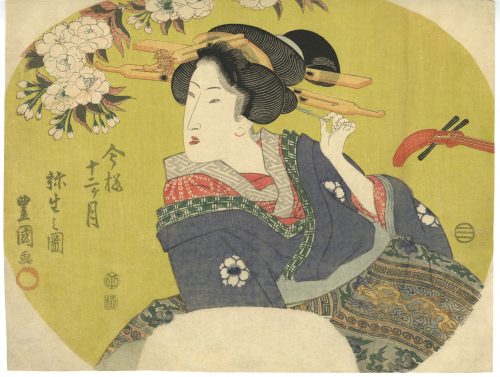 Title: Third lunar month [弥生] (Yayoi no zu); Series: Fashionable Twelve Months (Imayo juni-kagetsu). Another version of translation: Modern Beauties of Twelve Months. Artist: Utagawa Toyokuni I [歌川豊国] (1769–1825). Pubisher: Ibaya Senzaburō [伊場屋仙三郎] (Japanese, 1815 – 1869), seal: Dansendō [伊場仙]. Signed: Toyokuni ga and sealed with toshidama. Date-kiwame seal: Ushi (ox), Bunsei 5 (1822). Size: double-sheet uncut fan print ( aiban uchiwa-e), 219 x 295 mm.
Title: Third lunar month [弥生] (Yayoi no zu); Series: Fashionable Twelve Months (Imayo juni-kagetsu). Another version of translation: Modern Beauties of Twelve Months. Artist: Utagawa Toyokuni I [歌川豊国] (1769–1825). Pubisher: Ibaya Senzaburō [伊場屋仙三郎] (Japanese, 1815 – 1869), seal: Dansendō [伊場仙]. Signed: Toyokuni ga and sealed with toshidama. Date-kiwame seal: Ushi (ox), Bunsei 5 (1822). Size: double-sheet uncut fan print ( aiban uchiwa-e), 219 x 295 mm.

-
 Artist: Utagawa Kunisada [歌川 国貞] a.k.a. Utagawa Toyokuni III [三代歌川豊国] (Japanese, 1786 – 1865). Signed: Toyokuni ga [豊国 画] in a red toshidama cartouche. Publisher: Ibaya Senzaburō [伊場屋仙三郎] (Japanese, c. 1815 – 1869). Block carver: Yokokawa Takejirō [横川竹二郎] (Japanese, fl. 1845 – 1863); seal Hori Take [彫竹]. Double nanushi censor seals: Mera & Murata (1847-50). Title: Cool Breeze on Tenpōzan Hill in Naniwa [浪花天保山の涼] (Naniwa Tenpōzan no ryō). An uncut fan print (uchiwa-e), depicting a gentleman (most probably kabuki actor Nakamura Utaemon IV) holding a pipe with the view of Tenpōzan Hill [天保山] in Naniwa (Osaka) in the background. A distinctive structure on the left is the Sumiyoshi Lantern [住吉高灯篭] (Sumiyoshi takadōrō), which was destroyed by a typhoon in 1950. The character 翫 – moteasobu – on the gentleman’s robe means "take pleasure, play an instrument". Nakamura Utaemon IV [中村歌右衛門] (Japanese, 1796 – 1852); other names: Nakamura Shikan II, Nakamura Tsurusuke I, Nakamura Tōtarō. The character is visually similar to a gentleman drinking tea on a veranda under the shining moon from the series ‘Moon, Sun, Stars’ [月日星] (Getsu hi hoshi), see SVJP-0211-1.2016: The Moon.
Artist: Utagawa Kunisada [歌川 国貞] a.k.a. Utagawa Toyokuni III [三代歌川豊国] (Japanese, 1786 – 1865). Signed: Toyokuni ga [豊国 画] in a red toshidama cartouche. Publisher: Ibaya Senzaburō [伊場屋仙三郎] (Japanese, c. 1815 – 1869). Block carver: Yokokawa Takejirō [横川竹二郎] (Japanese, fl. 1845 – 1863); seal Hori Take [彫竹]. Double nanushi censor seals: Mera & Murata (1847-50). Title: Cool Breeze on Tenpōzan Hill in Naniwa [浪花天保山の涼] (Naniwa Tenpōzan no ryō). An uncut fan print (uchiwa-e), depicting a gentleman (most probably kabuki actor Nakamura Utaemon IV) holding a pipe with the view of Tenpōzan Hill [天保山] in Naniwa (Osaka) in the background. A distinctive structure on the left is the Sumiyoshi Lantern [住吉高灯篭] (Sumiyoshi takadōrō), which was destroyed by a typhoon in 1950. The character 翫 – moteasobu – on the gentleman’s robe means "take pleasure, play an instrument". Nakamura Utaemon IV [中村歌右衛門] (Japanese, 1796 – 1852); other names: Nakamura Shikan II, Nakamura Tsurusuke I, Nakamura Tōtarō. The character is visually similar to a gentleman drinking tea on a veranda under the shining moon from the series ‘Moon, Sun, Stars’ [月日星] (Getsu hi hoshi), see SVJP-0211-1.2016: The Moon. As noted by Horst Graebner, the gentleman also resembles the character on another Kunisada's actor print, published in 1852 (Waseda University Cultural Resources Database № 114-0232):
As noted by Horst Graebner, the gentleman also resembles the character on another Kunisada's actor print, published in 1852 (Waseda University Cultural Resources Database № 114-0232):

-
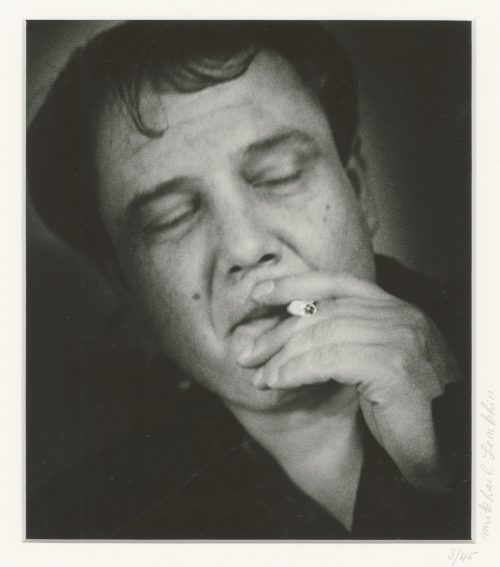 Photographic portrait of writer Vladimir Bukovsky with head tilted, closed eyes, and smoking a cigarette. Pencil-signed on the mat: 3/45 • Mikhail Lemkhin; on the back of the print: ink stamp ©MIKHAIL LEMKHIN, ink inscription ©mikhail Lemkhin; ink stamp: PHOTO BY: | MIKHAIL LEMKHIN | 2327 – 38th AVENUE | SAN FRANCISCO, CA 94116 | (415) 664-7677, pencil inscription 3/45 Mikhail Lemkhin; pencil inscription on the back of the mat: (top) ВЛАДИМИР БУКОВСКИЙ | VLADIMIR BUKOVSKY, (bottom) VI. Size: mat: 43.2 x 35.7 cm; window: 21.5 x 18.5 cm; print: 25.3 x 20.3 cm. Limited edition of 45, of which this is № 3, signed and stamped by the artist. Sitter: Vladimir Bukovsky [Владимир Константинович Буковский] (Russian, 1942 – 2019). Popularity: Bukovsky left the Soviet Union, where he was kept in prison for his political views, in exchange for Luis Alberto Corvalán, a Chilean communist. The event was commemorated in the following folk verse:
Photographic portrait of writer Vladimir Bukovsky with head tilted, closed eyes, and smoking a cigarette. Pencil-signed on the mat: 3/45 • Mikhail Lemkhin; on the back of the print: ink stamp ©MIKHAIL LEMKHIN, ink inscription ©mikhail Lemkhin; ink stamp: PHOTO BY: | MIKHAIL LEMKHIN | 2327 – 38th AVENUE | SAN FRANCISCO, CA 94116 | (415) 664-7677, pencil inscription 3/45 Mikhail Lemkhin; pencil inscription on the back of the mat: (top) ВЛАДИМИР БУКОВСКИЙ | VLADIMIR BUKOVSKY, (bottom) VI. Size: mat: 43.2 x 35.7 cm; window: 21.5 x 18.5 cm; print: 25.3 x 20.3 cm. Limited edition of 45, of which this is № 3, signed and stamped by the artist. Sitter: Vladimir Bukovsky [Владимир Константинович Буковский] (Russian, 1942 – 2019). Popularity: Bukovsky left the Soviet Union, where he was kept in prison for his political views, in exchange for Luis Alberto Corvalán, a Chilean communist. The event was commemorated in the following folk verse:Обменяли хулигана На Луиса Корвалана. Где б найти такую блядь, Чтоб на Брежнева сменять!
This can be translated as a Haiku:A troublemaker was exchanged for Luis Corvalán... Where to find a whore to exchange for Brezhnev?
-
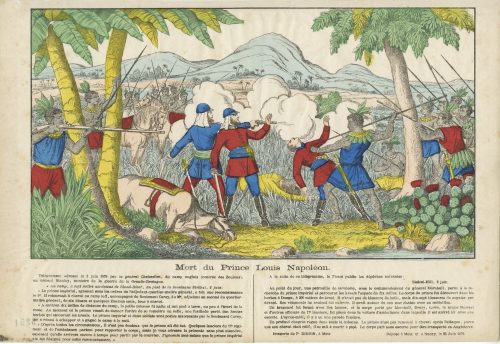 Hand-coloured woodcut on wove paper, 267 x 390 mm. On reverse: black ink stamp “5351”. Centre, under the image frame "Mort du Prince Louis Napoléon". Below left: "Télégramme adressé le 2 juin 1879 par le général Chelmsfort, du camp anglais (contrée des Zoulous), au colonel Stanley, ministre de la guerre de la Grande-Bretagne. « Au camp, à sept milles au-dessus de Blood-River, au pied de la montagne Stellezi, 2 juin: Le prince impérial, agissant sous les ordres de l'adjudant quartier-maitre général. a fait une reconnaissance le 1er. Il retournait à cheval au camp le 2 accompagné du lieutenant Carey, du 98e adjudant en second du quartier-maitre général. de six blancs et, quelques Zoulous amis, tous à cheval. A environ dix milles de distance du camp, la petite colonne fit halte at mit pied à terre, un peu à l’écart de la route. Au moment ou le prince venait de donner l'ordre de se remettre en selle. une fusillade partit des hautes herbes qui entourant les kraals. Le prince impérial et deux soldats sont portés manquants par le lieutenant Carey, qui a réussi à échapper et a gagné le camp à la nuit. D'après toutes les circonstances, il 'est pas douteux quo le prince ait été tué. Quelques lanciers du 17 régiment et de l'ambulance partent pour rapporter le corps; mais je vous adresse la présente sans plus attendre, espérant qu'elle arrivera encore à temps pour partir par le courrier. J’ignorais moi-même que le prince impérial eût été désigné pour cette reconnaissance. »" Below right: A la suite de le télégramme, le Times publie les dépêches suivantes: Stelezi-Hill, 2 juin. Au point du jour, une patrouille de cavalerie, sous le commandement du général Marshall. partit à la recherche du prince impérial et parcourut les kraals l'espace de dix milles. Le corps du prince fut découvert dans les herbes à Donga, à 300 mètres du kraal. Il n'avait pas de blessure de balle, mais dix-sept blessures de zagaies par devant. Ses vêtements lui avaient été enlevés. I avait autour du cou une chaine avec un médaillon. Un brancard fut formé avec les lances, et le corps porté par Marchall, Drury, Lowe, le mjor Stewart et d'autres officiers du 17e lanciers, fut. place dans la voiture d'ambulance dans laquelle il est arrivé ici avec une escorte. L'après-midi, il v a eu une parade funèbre. Un profond chagrin règne dans toute la colonne. Le prince n'est pas remonté à cheval après l’attique, parce que son cheval était rétif ; il se mit à courir à pied. Le corps part sous escorte pour être transporté en Angleterre. Bottom right: "Imagerie de P. DIDION, à Metz — Déposé à Metz et à Nancy, le 25 Juin 1879". Paulin Didion (French, 1831 – 1879) – publisher/printer.
Hand-coloured woodcut on wove paper, 267 x 390 mm. On reverse: black ink stamp “5351”. Centre, under the image frame "Mort du Prince Louis Napoléon". Below left: "Télégramme adressé le 2 juin 1879 par le général Chelmsfort, du camp anglais (contrée des Zoulous), au colonel Stanley, ministre de la guerre de la Grande-Bretagne. « Au camp, à sept milles au-dessus de Blood-River, au pied de la montagne Stellezi, 2 juin: Le prince impérial, agissant sous les ordres de l'adjudant quartier-maitre général. a fait une reconnaissance le 1er. Il retournait à cheval au camp le 2 accompagné du lieutenant Carey, du 98e adjudant en second du quartier-maitre général. de six blancs et, quelques Zoulous amis, tous à cheval. A environ dix milles de distance du camp, la petite colonne fit halte at mit pied à terre, un peu à l’écart de la route. Au moment ou le prince venait de donner l'ordre de se remettre en selle. une fusillade partit des hautes herbes qui entourant les kraals. Le prince impérial et deux soldats sont portés manquants par le lieutenant Carey, qui a réussi à échapper et a gagné le camp à la nuit. D'après toutes les circonstances, il 'est pas douteux quo le prince ait été tué. Quelques lanciers du 17 régiment et de l'ambulance partent pour rapporter le corps; mais je vous adresse la présente sans plus attendre, espérant qu'elle arrivera encore à temps pour partir par le courrier. J’ignorais moi-même que le prince impérial eût été désigné pour cette reconnaissance. »" Below right: A la suite de le télégramme, le Times publie les dépêches suivantes: Stelezi-Hill, 2 juin. Au point du jour, une patrouille de cavalerie, sous le commandement du général Marshall. partit à la recherche du prince impérial et parcourut les kraals l'espace de dix milles. Le corps du prince fut découvert dans les herbes à Donga, à 300 mètres du kraal. Il n'avait pas de blessure de balle, mais dix-sept blessures de zagaies par devant. Ses vêtements lui avaient été enlevés. I avait autour du cou une chaine avec un médaillon. Un brancard fut formé avec les lances, et le corps porté par Marchall, Drury, Lowe, le mjor Stewart et d'autres officiers du 17e lanciers, fut. place dans la voiture d'ambulance dans laquelle il est arrivé ici avec une escorte. L'après-midi, il v a eu une parade funèbre. Un profond chagrin règne dans toute la colonne. Le prince n'est pas remonté à cheval après l’attique, parce que son cheval était rétif ; il se mit à courir à pied. Le corps part sous escorte pour être transporté en Angleterre. Bottom right: "Imagerie de P. DIDION, à Metz — Déposé à Metz et à Nancy, le 25 Juin 1879". Paulin Didion (French, 1831 – 1879) – publisher/printer. -
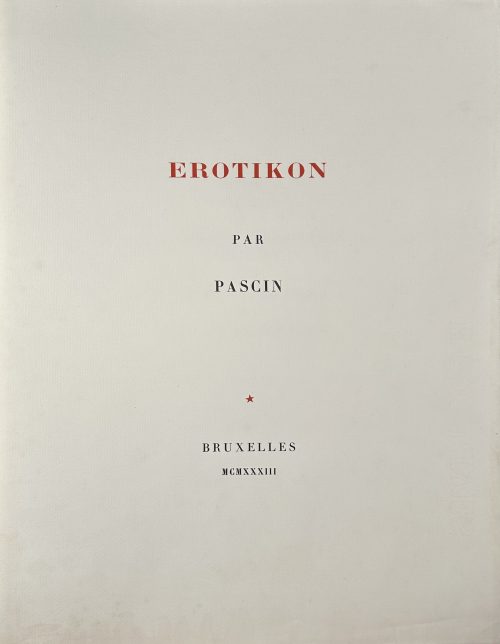 A portfolio of nine heliogravures after Jules Pascin. Cloth-backed cardboard portfolio 420 x 335 mm with 9 heliogravures on slightly tinted india paper, each numbered in pencil and mounted into a passe-partout 410 x 318 mm. Copy № 25 out of 40 printed on india (chine) paper. Copy № 25 of 40. Title (red and black): EROTIKON | PAR | PASCIN | ★ | BRUXELLES | MCMXXXIII || Limitation: CET | ALBUM | A ÉTÉ TIRÉ | A | QUARANTE ET UN EXEMPLAIRES | NUMÉROTÉS | DONT | UN EX. SUR PAPIER ANCIEN | & | QUARANTE EX. SUR CHINE | No (ms 25/40) || Catalogue raisonné: Dutel III № 1498. Seller's description:Neun Heliogravüren. 1933. Meist ca. 30 : 35 cm. Nummeriert. Exemplar 25/40 (Gesamtauflage 41). – Die Heliogravüren auf leicht getöntem China, jedes Blatt mit Bleistift nummeriert und in Passepartouts montiert. – Die neun Passepartouts eingelegt in zwei Büttenumschläge, einer mit Titel und dem nummerierten Auflagenvermerk, der zweite unbedruckt, ferner Büttenumschlag mit Titel in Rotdruck und Halbleinenchemise. – Die Heliogravüren erschienen 1933, drei Jahre nach Pascins Tod bei Daragnes in Paris mit der fingierten Angabe »Brüssel«. – Das berühmte Mappenwerk bildet eine der großen Seltenheiten der erotischen Kunst. Die Motive Pascins beschreibt das Bilderlexikon als »eine Art ›Boheme-Rokoko im Montmartre-Milieu‹« und lobt den Künstler: »Er ist ein außerordentlicher Zeichner, der es versteht, bei allem Zynismus, der seinen exhibitionistischen Charakter nicht verleugnet, auf diesem Kulturdünger eine neuartige Blume voll graziöser Schönheit erblühen zu lassen.« Mappe: 42 : 33,5 cm. – Der äußere Büttenumschlag mit leichtem Wasserrand. – Zwei Heliogravüren minimal stockfleckig, sonst tadellos und absolut vollständig. Dutel 1498 (mit Auflagenvarianten). – Der kalte Blick S. 198ff. – Bilderlexikon II, 718.
A portfolio of nine heliogravures after Jules Pascin. Cloth-backed cardboard portfolio 420 x 335 mm with 9 heliogravures on slightly tinted india paper, each numbered in pencil and mounted into a passe-partout 410 x 318 mm. Copy № 25 out of 40 printed on india (chine) paper. Copy № 25 of 40. Title (red and black): EROTIKON | PAR | PASCIN | ★ | BRUXELLES | MCMXXXIII || Limitation: CET | ALBUM | A ÉTÉ TIRÉ | A | QUARANTE ET UN EXEMPLAIRES | NUMÉROTÉS | DONT | UN EX. SUR PAPIER ANCIEN | & | QUARANTE EX. SUR CHINE | No (ms 25/40) || Catalogue raisonné: Dutel III № 1498. Seller's description:Neun Heliogravüren. 1933. Meist ca. 30 : 35 cm. Nummeriert. Exemplar 25/40 (Gesamtauflage 41). – Die Heliogravüren auf leicht getöntem China, jedes Blatt mit Bleistift nummeriert und in Passepartouts montiert. – Die neun Passepartouts eingelegt in zwei Büttenumschläge, einer mit Titel und dem nummerierten Auflagenvermerk, der zweite unbedruckt, ferner Büttenumschlag mit Titel in Rotdruck und Halbleinenchemise. – Die Heliogravüren erschienen 1933, drei Jahre nach Pascins Tod bei Daragnes in Paris mit der fingierten Angabe »Brüssel«. – Das berühmte Mappenwerk bildet eine der großen Seltenheiten der erotischen Kunst. Die Motive Pascins beschreibt das Bilderlexikon als »eine Art ›Boheme-Rokoko im Montmartre-Milieu‹« und lobt den Künstler: »Er ist ein außerordentlicher Zeichner, der es versteht, bei allem Zynismus, der seinen exhibitionistischen Charakter nicht verleugnet, auf diesem Kulturdünger eine neuartige Blume voll graziöser Schönheit erblühen zu lassen.« Mappe: 42 : 33,5 cm. – Der äußere Büttenumschlag mit leichtem Wasserrand. – Zwei Heliogravüren minimal stockfleckig, sonst tadellos und absolut vollständig. Dutel 1498 (mit Auflagenvarianten). – Der kalte Blick S. 198ff. – Bilderlexikon II, 718. -
 Bando Mitsugorō III as Lady Iwafuji and Nakamura Matsue III as Lady Onoe, 1821.「局岩ふじ 坂東三津五郎」(三代)、「中老尾上 中村松江」(三代) in kabuki play Kagamiyama Kokyô no Nishikie [鏡山旧錦繪] (Mirror mountain: A women’s treasury of loyalty); author: Yô Yôdai. Artist: Shunkōsai Hokushū (春好斎 北洲), who is also known as Shunkō IV, active from about 1802 to 1832. Actors: Bandō Mitsugorō III [三代目 坂東 三津五郎] (Japanese, 1775 – 1831); other names: Bandō Minosuke I, Morita Kanjirô II, Bandō Mitahachi I, Bandō Minosuke I, Bandō Mitahachi I. Nakamura Matsue III [三代目中村松江] (Japanese, 1786-1855); other names: Nakamura Sankō I, Nakamura Tomijūrō II, Ichikawa Kumatarō. Year: 1821 (Bunsei 4), 1st month. Publisher: Wataya Kihei (Wataki) (Japanese, fl. c. 1809 – 1885) Signed Shunkôsai Hokushû ga 春好斎北洲画. MFA Accession № 11.35375. MFA description: "Play: Keisei Kagamiyama (Mirror Mountain, a Courtesan Play). Theatre: Kado けいせい双鏡山(けいせいかがみやま)角. Ref.: [LIB-1193.2013] Leiter. Kabuki Encyclopedia, p. 156; [LIB-0879-2.2015] Kabuki plays on stage (vol. 2): 1773-1799, pp. 172-212.
Bando Mitsugorō III as Lady Iwafuji and Nakamura Matsue III as Lady Onoe, 1821.「局岩ふじ 坂東三津五郎」(三代)、「中老尾上 中村松江」(三代) in kabuki play Kagamiyama Kokyô no Nishikie [鏡山旧錦繪] (Mirror mountain: A women’s treasury of loyalty); author: Yô Yôdai. Artist: Shunkōsai Hokushū (春好斎 北洲), who is also known as Shunkō IV, active from about 1802 to 1832. Actors: Bandō Mitsugorō III [三代目 坂東 三津五郎] (Japanese, 1775 – 1831); other names: Bandō Minosuke I, Morita Kanjirô II, Bandō Mitahachi I, Bandō Minosuke I, Bandō Mitahachi I. Nakamura Matsue III [三代目中村松江] (Japanese, 1786-1855); other names: Nakamura Sankō I, Nakamura Tomijūrō II, Ichikawa Kumatarō. Year: 1821 (Bunsei 4), 1st month. Publisher: Wataya Kihei (Wataki) (Japanese, fl. c. 1809 – 1885) Signed Shunkôsai Hokushû ga 春好斎北洲画. MFA Accession № 11.35375. MFA description: "Play: Keisei Kagamiyama (Mirror Mountain, a Courtesan Play). Theatre: Kado けいせい双鏡山(けいせいかがみやま)角. Ref.: [LIB-1193.2013] Leiter. Kabuki Encyclopedia, p. 156; [LIB-0879-2.2015] Kabuki plays on stage (vol. 2): 1773-1799, pp. 172-212. -
 Richard Parkes Bonington (1802–1828 ). British/French. Evreux: Tour du Gros Horloge (Evreux: Large Clock Tower). Inscription: The tower was built in 1417 when the area was ruled by England. Lithograph. From the Taylor and Nodier set "Normandie", Vol. II, pl. 226. 1824. MET# 22.87.2. Catalogue Raisonné: Curtis 1939, no. 19. MET description: "This view in the French town of Evreux focuses on the clock tower, with vendors and customers in the street below. Bonington produced the print for the multi-volume series directed by Baron Isidore Taylor, Charles Nodier and Alphonse de Cailleux titled "Voyages Pittoresques et Romantiques dans l'Ancienne France" (Picturesque and Romantic Travels through Historic France). This image appears in volume 2, devoted to Normandy."
Richard Parkes Bonington (1802–1828 ). British/French. Evreux: Tour du Gros Horloge (Evreux: Large Clock Tower). Inscription: The tower was built in 1417 when the area was ruled by England. Lithograph. From the Taylor and Nodier set "Normandie", Vol. II, pl. 226. 1824. MET# 22.87.2. Catalogue Raisonné: Curtis 1939, no. 19. MET description: "This view in the French town of Evreux focuses on the clock tower, with vendors and customers in the street below. Bonington produced the print for the multi-volume series directed by Baron Isidore Taylor, Charles Nodier and Alphonse de Cailleux titled "Voyages Pittoresques et Romantiques dans l'Ancienne France" (Picturesque and Romantic Travels through Historic France). This image appears in volume 2, devoted to Normandy." -
 Utagawa Kunisada [歌川 国貞] a.k.a. Utagawa Toyokuni III [三代歌川豊国] (Japanese, 1786 – 1865)
Utagawa Kunisada [歌川 国貞] a.k.a. Utagawa Toyokuni III [三代歌川豊国] (Japanese, 1786 – 1865)Promotional fan for a hairpin shop, with a poem by Ichikawa Danjuro VII, signed Hakuen.
Date seal plus rectangular kiwame seal: Bunsei 8 (1825).
Size: Fan print. Uchiwa-e (27.5 x 21.1 cm) Publisher seal: Maru-To (2) (Marks U204). Date seal plus rectangular kiwame seal: Bunsei 8 (1825). -
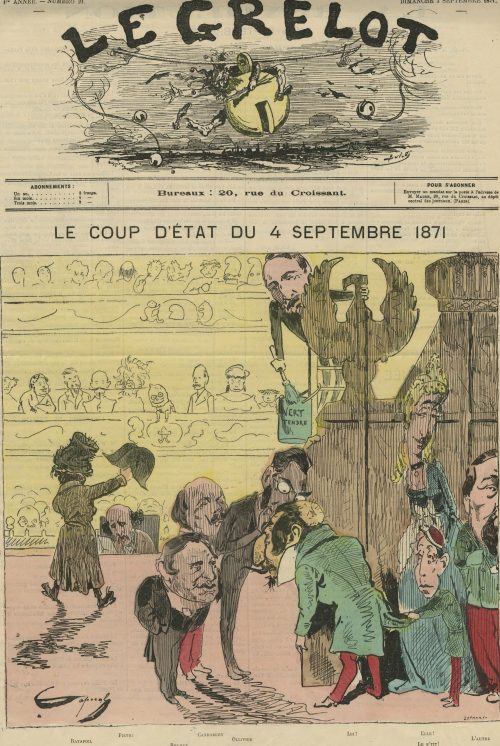 Le Grelot / journal illustré politique et satirique, №21, dimanche, 3 septembre 1871. Artist: Caporal (signed in the lower-left corner) Engraver/Printer: J. Lefman (signed LEFMAN SC in the lower-right corner) Title: LE COUP D'ÉTAT DU 4 SEPTEMBRE 1871. The Coup d'Etat of September 4th 1871. The artist equalled the 4th of September revolution when Napoleon III was ousted and the Second Empire collapsed, to a coup d'Etat. Although the number is marked September 3, it is dedicated to the events of September 4th. This was a usual French newspaper practice to postdate their issues. That's why they almost always operated with categories such as "today", "yesterday", and "tomorrow" instead of definitive calendar dates. "Le Grelot" means "The Sleigh Bell". Personages: Ratapoil – fictional personage invented by Honoré Daumier (French, 1808 – 1879), a Napoleon III caricaturized figure. Ratapoil is addressing the audience holding up Napoléon Bonaparte's tricorn cocked hat. Pietri – Joseph Marie Piétri [Joachim Piétri] (French, – is sitting in the first row, taking notes. Rouher – Eugène Rouher (French, 1814 – 1884), president of the Senat. Canrobert – François Marcellin Certain de Canrobert (French, 1809 – 1895), French Marshal, captured by the Prussian army in Metz with Marshal Bazaine during the surrender of Metz on October 28, 1870. Ollivier – Olivier Émile Ollivier (French, 1825 – 1913), head of the government. Hiding behind the theater decoration are: Napoleon III (Lui!), his wife Eugénie (Elle!), their son Prince Imperial (Le P'tit!), and Pierre Bonaparte (L'Autre). Sitting in the theatre box facing the scene: Adolphe Thiers (French, 1797 – 1877), Jules Favre (French, 1809 – 1880), Louis-Jules Trochu [Le General Trochu] (French, 1815 – 1896), and the other members of the "Government of National Defence". On the gallery: youngsters and two men in sans-culottes hats. An unidentified person on a ladder holding to an eagle figure is having a paintbrush and a bucket with 'tender green' paint. Ref: Musée Carnavalet
Le Grelot / journal illustré politique et satirique, №21, dimanche, 3 septembre 1871. Artist: Caporal (signed in the lower-left corner) Engraver/Printer: J. Lefman (signed LEFMAN SC in the lower-right corner) Title: LE COUP D'ÉTAT DU 4 SEPTEMBRE 1871. The Coup d'Etat of September 4th 1871. The artist equalled the 4th of September revolution when Napoleon III was ousted and the Second Empire collapsed, to a coup d'Etat. Although the number is marked September 3, it is dedicated to the events of September 4th. This was a usual French newspaper practice to postdate their issues. That's why they almost always operated with categories such as "today", "yesterday", and "tomorrow" instead of definitive calendar dates. "Le Grelot" means "The Sleigh Bell". Personages: Ratapoil – fictional personage invented by Honoré Daumier (French, 1808 – 1879), a Napoleon III caricaturized figure. Ratapoil is addressing the audience holding up Napoléon Bonaparte's tricorn cocked hat. Pietri – Joseph Marie Piétri [Joachim Piétri] (French, – is sitting in the first row, taking notes. Rouher – Eugène Rouher (French, 1814 – 1884), president of the Senat. Canrobert – François Marcellin Certain de Canrobert (French, 1809 – 1895), French Marshal, captured by the Prussian army in Metz with Marshal Bazaine during the surrender of Metz on October 28, 1870. Ollivier – Olivier Émile Ollivier (French, 1825 – 1913), head of the government. Hiding behind the theater decoration are: Napoleon III (Lui!), his wife Eugénie (Elle!), their son Prince Imperial (Le P'tit!), and Pierre Bonaparte (L'Autre). Sitting in the theatre box facing the scene: Adolphe Thiers (French, 1797 – 1877), Jules Favre (French, 1809 – 1880), Louis-Jules Trochu [Le General Trochu] (French, 1815 – 1896), and the other members of the "Government of National Defence". On the gallery: youngsters and two men in sans-culottes hats. An unidentified person on a ladder holding to an eagle figure is having a paintbrush and a bucket with 'tender green' paint. Ref: Musée Carnavalet -
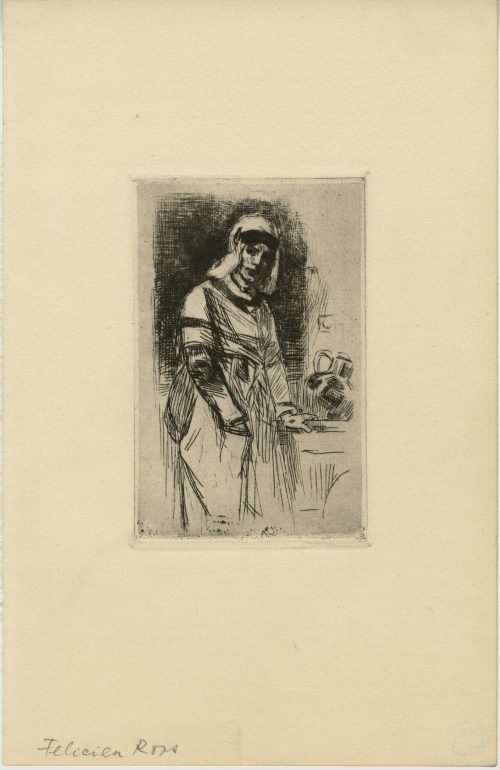
A woman from Antwerp or a servant, another title "Laitière anversoise"; 2nd state. Etching on wove paper. Owner's stamp LVM on verso.
Dimensions: Paper: 24.4 x 15.8 cm; Image: 12 x 7.5 cm
Catalogue raisonné: Arthur Hubschmid (1977): 343.





